How Effective Leadership and Open Communication Increase Hotel Centennial's Productivity
VerifiedAdded on 2023/04/07
|32
|5889
|261
AI Summary
This report analyzes the effectiveness of leadership and open communication on the increment of productivity of hotel Centennial. It includes a literature review, methodology, findings, and recommendations.
Contribute Materials
Your contribution can guide someone’s learning journey. Share your
documents today.
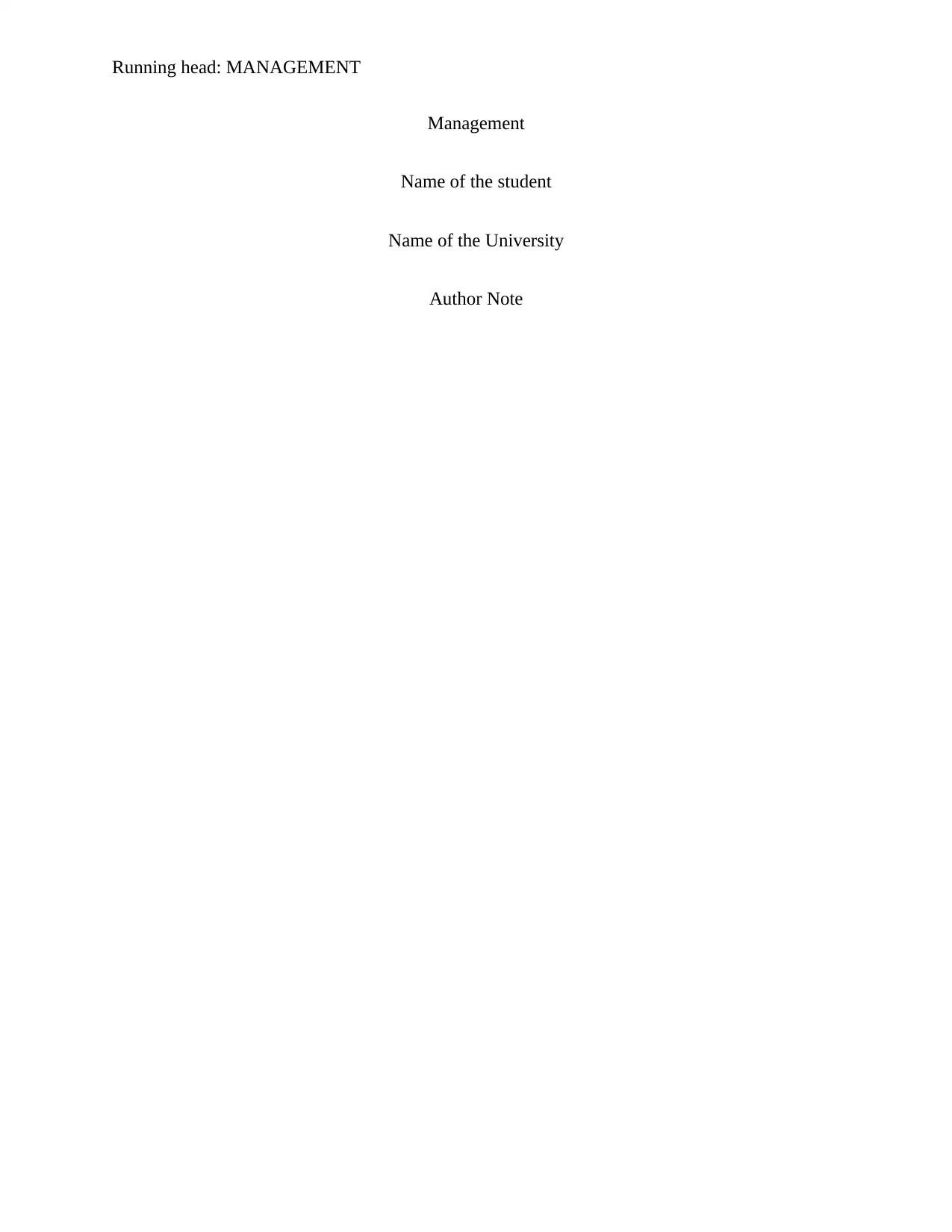
Running head: MANAGEMENT
Management
Name of the student
Name of the University
Author Note
Management
Name of the student
Name of the University
Author Note
Secure Best Marks with AI Grader
Need help grading? Try our AI Grader for instant feedback on your assignments.
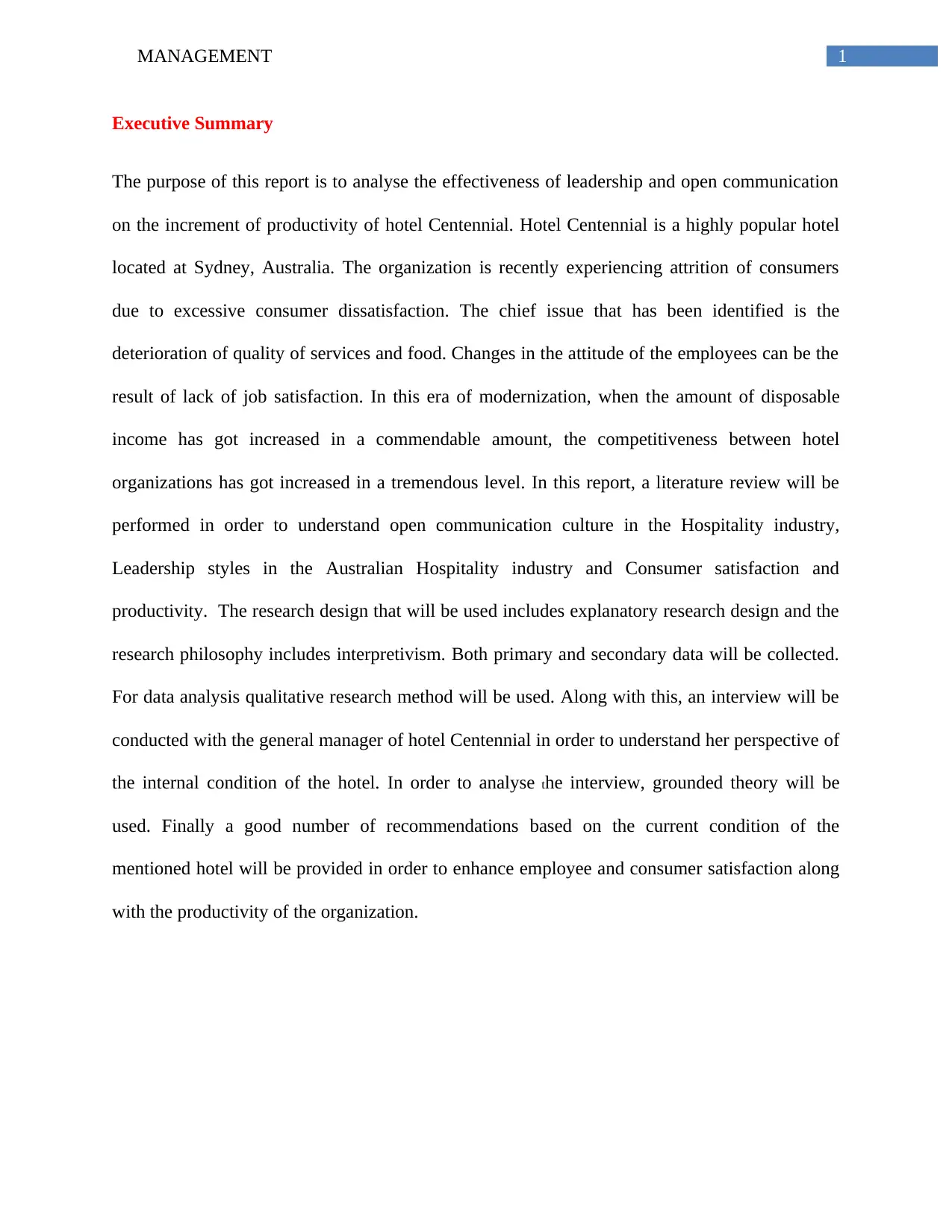
1MANAGEMENT
Executive Summary
The purpose of this report is to analyse the effectiveness of leadership and open communication
on the increment of productivity of hotel Centennial. Hotel Centennial is a highly popular hotel
located at Sydney, Australia. The organization is recently experiencing attrition of consumers
due to excessive consumer dissatisfaction. The chief issue that has been identified is the
deterioration of quality of services and food. Changes in the attitude of the employees can be the
result of lack of job satisfaction. In this era of modernization, when the amount of disposable
income has got increased in a commendable amount, the competitiveness between hotel
organizations has got increased in a tremendous level. In this report, a literature review will be
performed in order to understand open communication culture in the Hospitality industry,
Leadership styles in the Australian Hospitality industry and Consumer satisfaction and
productivity. The research design that will be used includes explanatory research design and the
research philosophy includes interpretivism. Both primary and secondary data will be collected.
For data analysis qualitative research method will be used. Along with this, an interview will be
conducted with the general manager of hotel Centennial in order to understand her perspective of
the internal condition of the hotel. In order to analyse the interview, grounded theory will be
used. Finally a good number of recommendations based on the current condition of the
mentioned hotel will be provided in order to enhance employee and consumer satisfaction along
with the productivity of the organization.
Executive Summary
The purpose of this report is to analyse the effectiveness of leadership and open communication
on the increment of productivity of hotel Centennial. Hotel Centennial is a highly popular hotel
located at Sydney, Australia. The organization is recently experiencing attrition of consumers
due to excessive consumer dissatisfaction. The chief issue that has been identified is the
deterioration of quality of services and food. Changes in the attitude of the employees can be the
result of lack of job satisfaction. In this era of modernization, when the amount of disposable
income has got increased in a commendable amount, the competitiveness between hotel
organizations has got increased in a tremendous level. In this report, a literature review will be
performed in order to understand open communication culture in the Hospitality industry,
Leadership styles in the Australian Hospitality industry and Consumer satisfaction and
productivity. The research design that will be used includes explanatory research design and the
research philosophy includes interpretivism. Both primary and secondary data will be collected.
For data analysis qualitative research method will be used. Along with this, an interview will be
conducted with the general manager of hotel Centennial in order to understand her perspective of
the internal condition of the hotel. In order to analyse the interview, grounded theory will be
used. Finally a good number of recommendations based on the current condition of the
mentioned hotel will be provided in order to enhance employee and consumer satisfaction along
with the productivity of the organization.
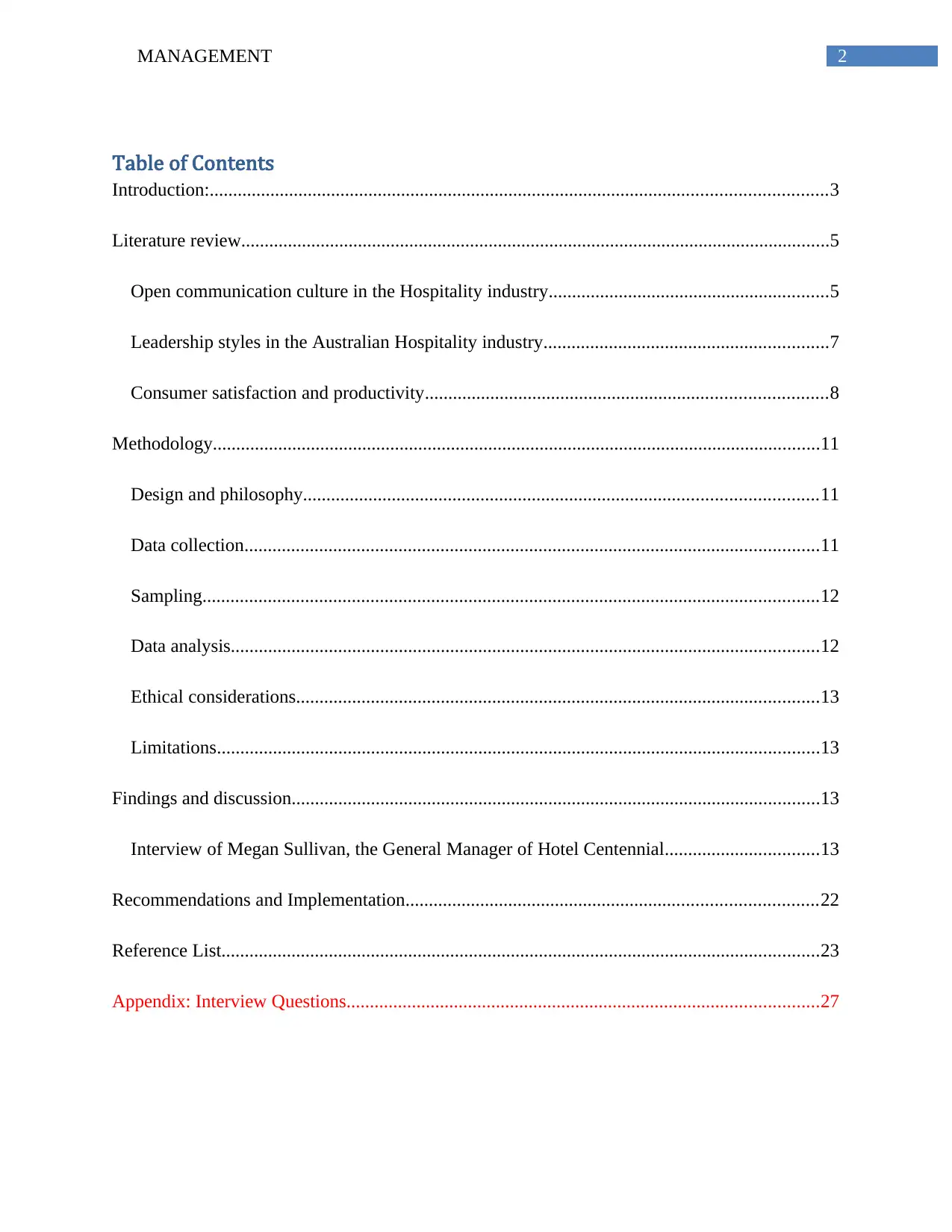
2MANAGEMENT
Table of Contents
Introduction:....................................................................................................................................3
Literature review..............................................................................................................................5
Open communication culture in the Hospitality industry............................................................5
Leadership styles in the Australian Hospitality industry.............................................................7
Consumer satisfaction and productivity......................................................................................8
Methodology..................................................................................................................................11
Design and philosophy..............................................................................................................11
Data collection...........................................................................................................................11
Sampling....................................................................................................................................12
Data analysis..............................................................................................................................12
Ethical considerations................................................................................................................13
Limitations.................................................................................................................................13
Findings and discussion.................................................................................................................13
Interview of Megan Sullivan, the General Manager of Hotel Centennial.................................13
Recommendations and Implementation........................................................................................22
Reference List................................................................................................................................23
Appendix: Interview Questions.....................................................................................................27
Table of Contents
Introduction:....................................................................................................................................3
Literature review..............................................................................................................................5
Open communication culture in the Hospitality industry............................................................5
Leadership styles in the Australian Hospitality industry.............................................................7
Consumer satisfaction and productivity......................................................................................8
Methodology..................................................................................................................................11
Design and philosophy..............................................................................................................11
Data collection...........................................................................................................................11
Sampling....................................................................................................................................12
Data analysis..............................................................................................................................12
Ethical considerations................................................................................................................13
Limitations.................................................................................................................................13
Findings and discussion.................................................................................................................13
Interview of Megan Sullivan, the General Manager of Hotel Centennial.................................13
Recommendations and Implementation........................................................................................22
Reference List................................................................................................................................23
Appendix: Interview Questions.....................................................................................................27
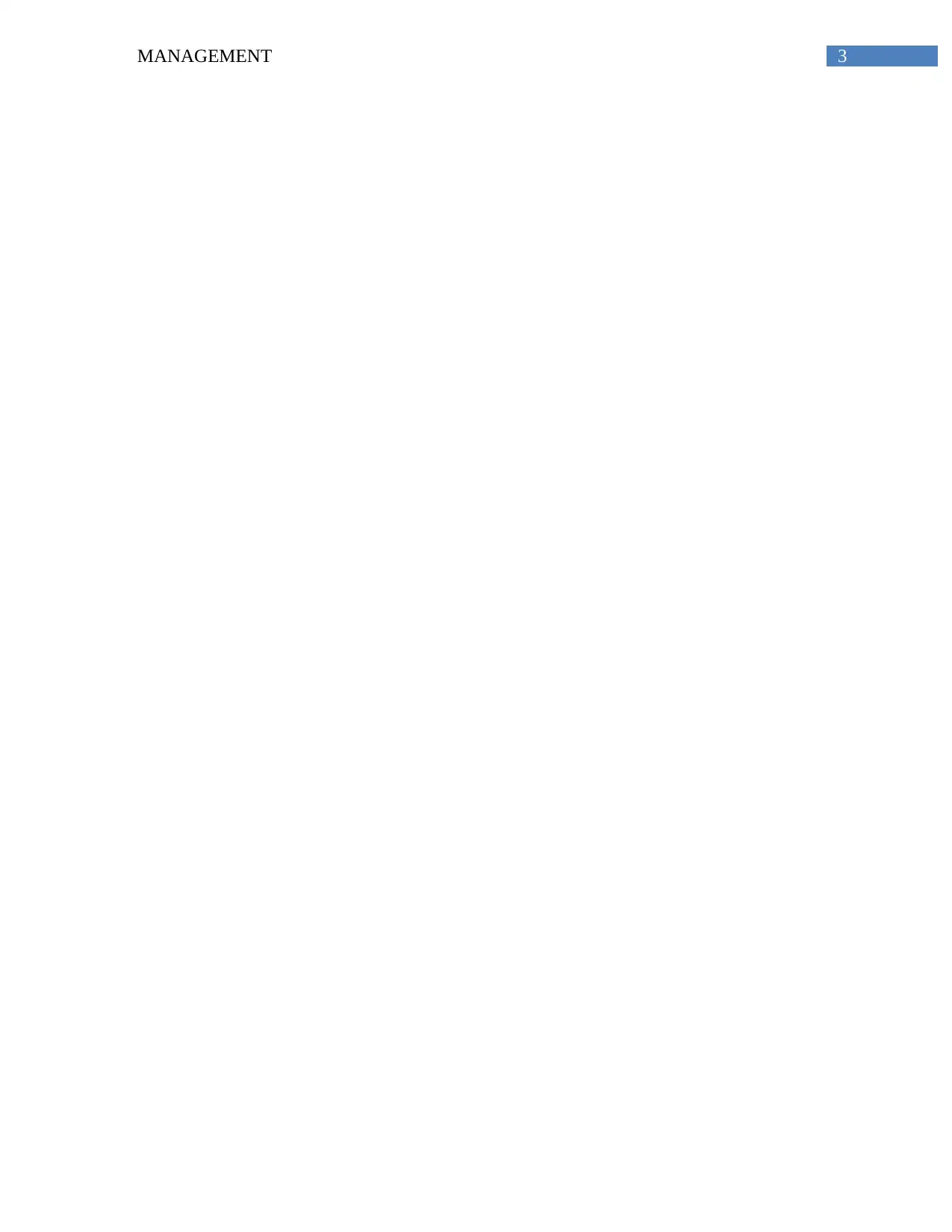
3MANAGEMENT
Secure Best Marks with AI Grader
Need help grading? Try our AI Grader for instant feedback on your assignments.
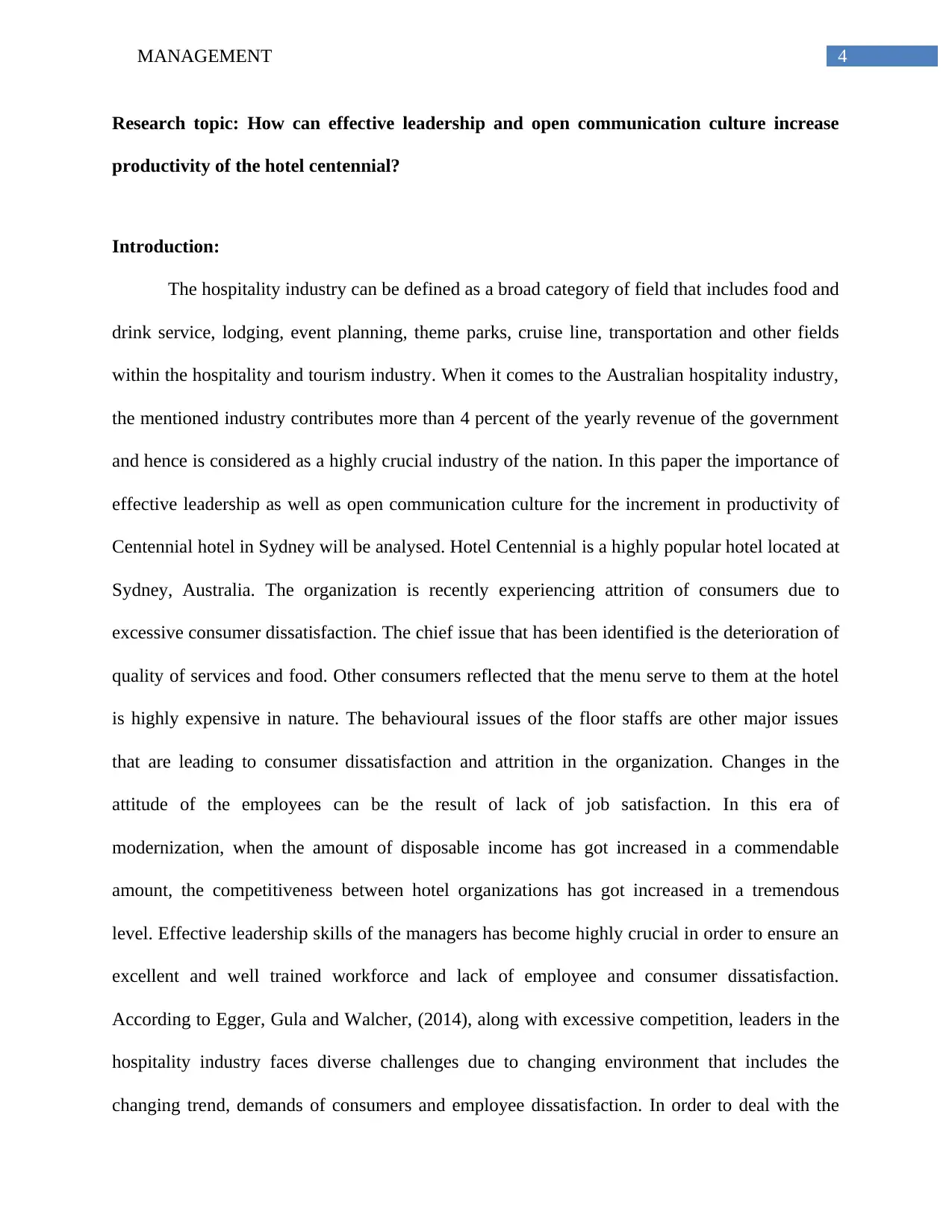
4MANAGEMENT
Research topic: How can effective leadership and open communication culture increase
productivity of the hotel centennial?
Introduction:
The hospitality industry can be defined as a broad category of field that includes food and
drink service, lodging, event planning, theme parks, cruise line, transportation and other fields
within the hospitality and tourism industry. When it comes to the Australian hospitality industry,
the mentioned industry contributes more than 4 percent of the yearly revenue of the government
and hence is considered as a highly crucial industry of the nation. In this paper the importance of
effective leadership as well as open communication culture for the increment in productivity of
Centennial hotel in Sydney will be analysed. Hotel Centennial is a highly popular hotel located at
Sydney, Australia. The organization is recently experiencing attrition of consumers due to
excessive consumer dissatisfaction. The chief issue that has been identified is the deterioration of
quality of services and food. Other consumers reflected that the menu serve to them at the hotel
is highly expensive in nature. The behavioural issues of the floor staffs are other major issues
that are leading to consumer dissatisfaction and attrition in the organization. Changes in the
attitude of the employees can be the result of lack of job satisfaction. In this era of
modernization, when the amount of disposable income has got increased in a commendable
amount, the competitiveness between hotel organizations has got increased in a tremendous
level. Effective leadership skills of the managers has become highly crucial in order to ensure an
excellent and well trained workforce and lack of employee and consumer dissatisfaction.
According to Egger, Gula and Walcher, (2014), along with excessive competition, leaders in the
hospitality industry faces diverse challenges due to changing environment that includes the
changing trend, demands of consumers and employee dissatisfaction. In order to deal with the
Research topic: How can effective leadership and open communication culture increase
productivity of the hotel centennial?
Introduction:
The hospitality industry can be defined as a broad category of field that includes food and
drink service, lodging, event planning, theme parks, cruise line, transportation and other fields
within the hospitality and tourism industry. When it comes to the Australian hospitality industry,
the mentioned industry contributes more than 4 percent of the yearly revenue of the government
and hence is considered as a highly crucial industry of the nation. In this paper the importance of
effective leadership as well as open communication culture for the increment in productivity of
Centennial hotel in Sydney will be analysed. Hotel Centennial is a highly popular hotel located at
Sydney, Australia. The organization is recently experiencing attrition of consumers due to
excessive consumer dissatisfaction. The chief issue that has been identified is the deterioration of
quality of services and food. Other consumers reflected that the menu serve to them at the hotel
is highly expensive in nature. The behavioural issues of the floor staffs are other major issues
that are leading to consumer dissatisfaction and attrition in the organization. Changes in the
attitude of the employees can be the result of lack of job satisfaction. In this era of
modernization, when the amount of disposable income has got increased in a commendable
amount, the competitiveness between hotel organizations has got increased in a tremendous
level. Effective leadership skills of the managers has become highly crucial in order to ensure an
excellent and well trained workforce and lack of employee and consumer dissatisfaction.
According to Egger, Gula and Walcher, (2014), along with excessive competition, leaders in the
hospitality industry faces diverse challenges due to changing environment that includes the
changing trend, demands of consumers and employee dissatisfaction. In order to deal with the
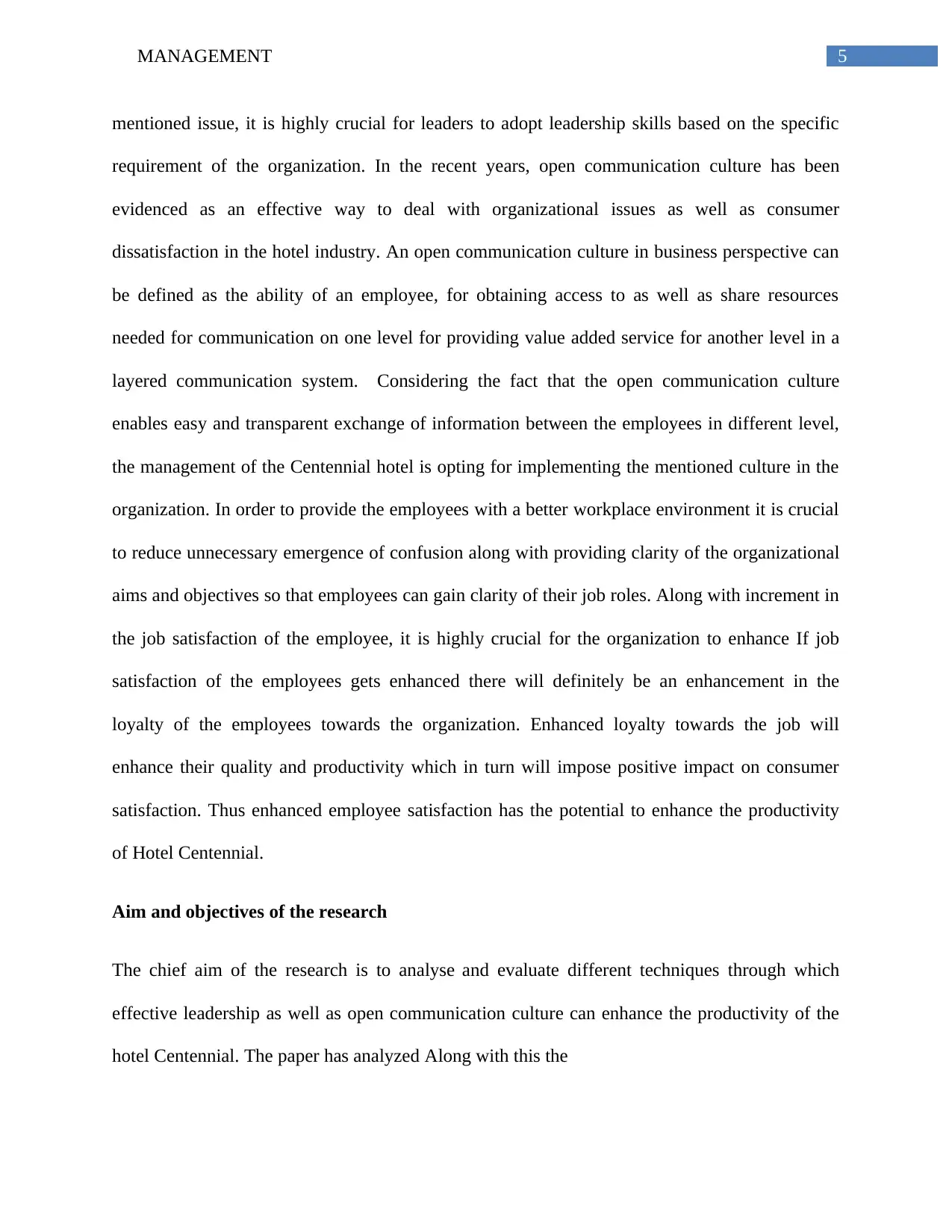
5MANAGEMENT
mentioned issue, it is highly crucial for leaders to adopt leadership skills based on the specific
requirement of the organization. In the recent years, open communication culture has been
evidenced as an effective way to deal with organizational issues as well as consumer
dissatisfaction in the hotel industry. An open communication culture in business perspective can
be defined as the ability of an employee, for obtaining access to as well as share resources
needed for communication on one level for providing value added service for another level in a
layered communication system. Considering the fact that the open communication culture
enables easy and transparent exchange of information between the employees in different level,
the management of the Centennial hotel is opting for implementing the mentioned culture in the
organization. In order to provide the employees with a better workplace environment it is crucial
to reduce unnecessary emergence of confusion along with providing clarity of the organizational
aims and objectives so that employees can gain clarity of their job roles. Along with increment in
the job satisfaction of the employee, it is highly crucial for the organization to enhance If job
satisfaction of the employees gets enhanced there will definitely be an enhancement in the
loyalty of the employees towards the organization. Enhanced loyalty towards the job will
enhance their quality and productivity which in turn will impose positive impact on consumer
satisfaction. Thus enhanced employee satisfaction has the potential to enhance the productivity
of Hotel Centennial.
Aim and objectives of the research
The chief aim of the research is to analyse and evaluate different techniques through which
effective leadership as well as open communication culture can enhance the productivity of the
hotel Centennial. The paper has analyzed Along with this the
mentioned issue, it is highly crucial for leaders to adopt leadership skills based on the specific
requirement of the organization. In the recent years, open communication culture has been
evidenced as an effective way to deal with organizational issues as well as consumer
dissatisfaction in the hotel industry. An open communication culture in business perspective can
be defined as the ability of an employee, for obtaining access to as well as share resources
needed for communication on one level for providing value added service for another level in a
layered communication system. Considering the fact that the open communication culture
enables easy and transparent exchange of information between the employees in different level,
the management of the Centennial hotel is opting for implementing the mentioned culture in the
organization. In order to provide the employees with a better workplace environment it is crucial
to reduce unnecessary emergence of confusion along with providing clarity of the organizational
aims and objectives so that employees can gain clarity of their job roles. Along with increment in
the job satisfaction of the employee, it is highly crucial for the organization to enhance If job
satisfaction of the employees gets enhanced there will definitely be an enhancement in the
loyalty of the employees towards the organization. Enhanced loyalty towards the job will
enhance their quality and productivity which in turn will impose positive impact on consumer
satisfaction. Thus enhanced employee satisfaction has the potential to enhance the productivity
of Hotel Centennial.
Aim and objectives of the research
The chief aim of the research is to analyse and evaluate different techniques through which
effective leadership as well as open communication culture can enhance the productivity of the
hotel Centennial. The paper has analyzed Along with this the
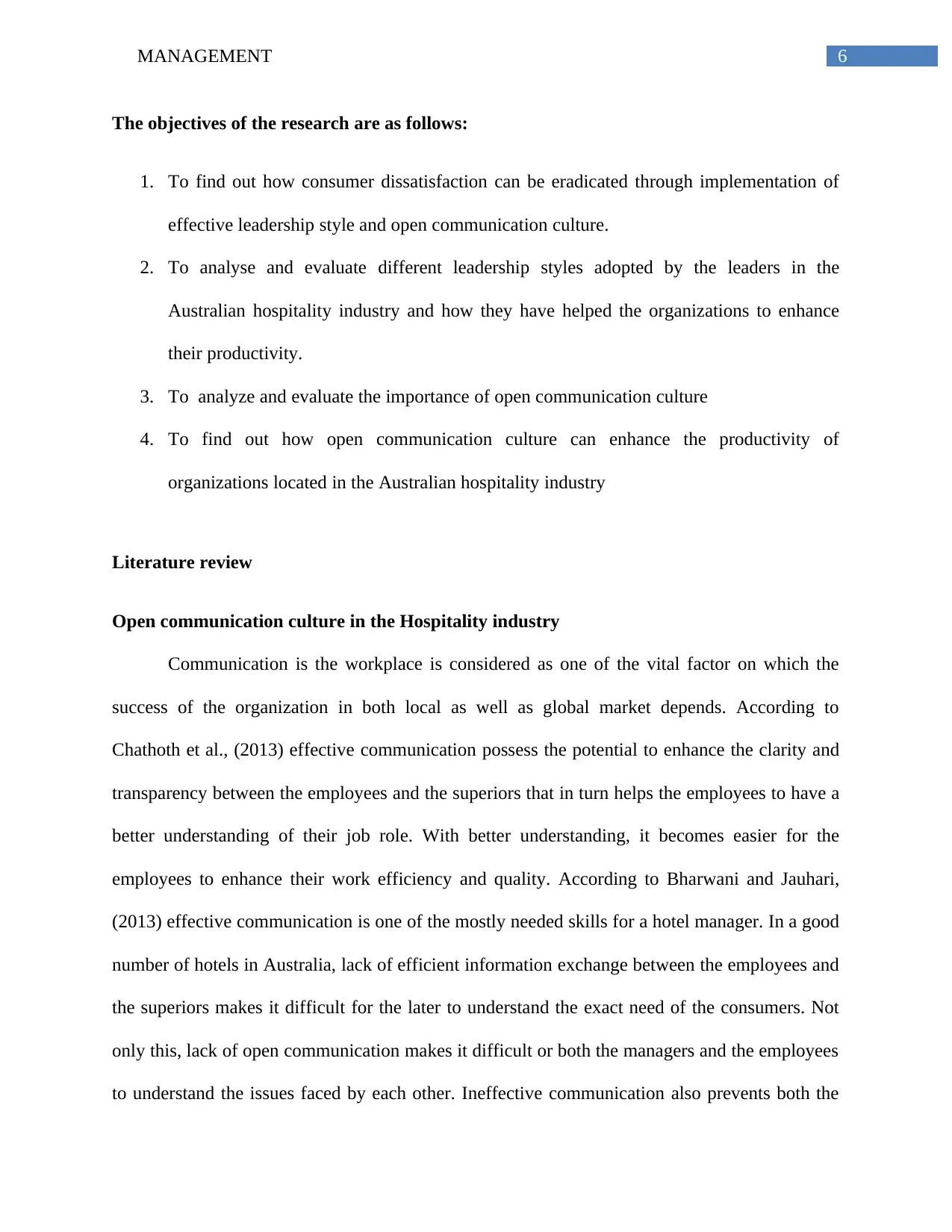
6MANAGEMENT
The objectives of the research are as follows:
1. To find out how consumer dissatisfaction can be eradicated through implementation of
effective leadership style and open communication culture.
2. To analyse and evaluate different leadership styles adopted by the leaders in the
Australian hospitality industry and how they have helped the organizations to enhance
their productivity.
3. To analyze and evaluate the importance of open communication culture
4. To find out how open communication culture can enhance the productivity of
organizations located in the Australian hospitality industry
Literature review
Open communication culture in the Hospitality industry
Communication is the workplace is considered as one of the vital factor on which the
success of the organization in both local as well as global market depends. According to
Chathoth et al., (2013) effective communication possess the potential to enhance the clarity and
transparency between the employees and the superiors that in turn helps the employees to have a
better understanding of their job role. With better understanding, it becomes easier for the
employees to enhance their work efficiency and quality. According to Bharwani and Jauhari,
(2013) effective communication is one of the mostly needed skills for a hotel manager. In a good
number of hotels in Australia, lack of efficient information exchange between the employees and
the superiors makes it difficult for the later to understand the exact need of the consumers. Not
only this, lack of open communication makes it difficult or both the managers and the employees
to understand the issues faced by each other. Ineffective communication also prevents both the
The objectives of the research are as follows:
1. To find out how consumer dissatisfaction can be eradicated through implementation of
effective leadership style and open communication culture.
2. To analyse and evaluate different leadership styles adopted by the leaders in the
Australian hospitality industry and how they have helped the organizations to enhance
their productivity.
3. To analyze and evaluate the importance of open communication culture
4. To find out how open communication culture can enhance the productivity of
organizations located in the Australian hospitality industry
Literature review
Open communication culture in the Hospitality industry
Communication is the workplace is considered as one of the vital factor on which the
success of the organization in both local as well as global market depends. According to
Chathoth et al., (2013) effective communication possess the potential to enhance the clarity and
transparency between the employees and the superiors that in turn helps the employees to have a
better understanding of their job role. With better understanding, it becomes easier for the
employees to enhance their work efficiency and quality. According to Bharwani and Jauhari,
(2013) effective communication is one of the mostly needed skills for a hotel manager. In a good
number of hotels in Australia, lack of efficient information exchange between the employees and
the superiors makes it difficult for the later to understand the exact need of the consumers. Not
only this, lack of open communication makes it difficult or both the managers and the employees
to understand the issues faced by each other. Ineffective communication also prevents both the
Paraphrase This Document
Need a fresh take? Get an instant paraphrase of this document with our AI Paraphraser
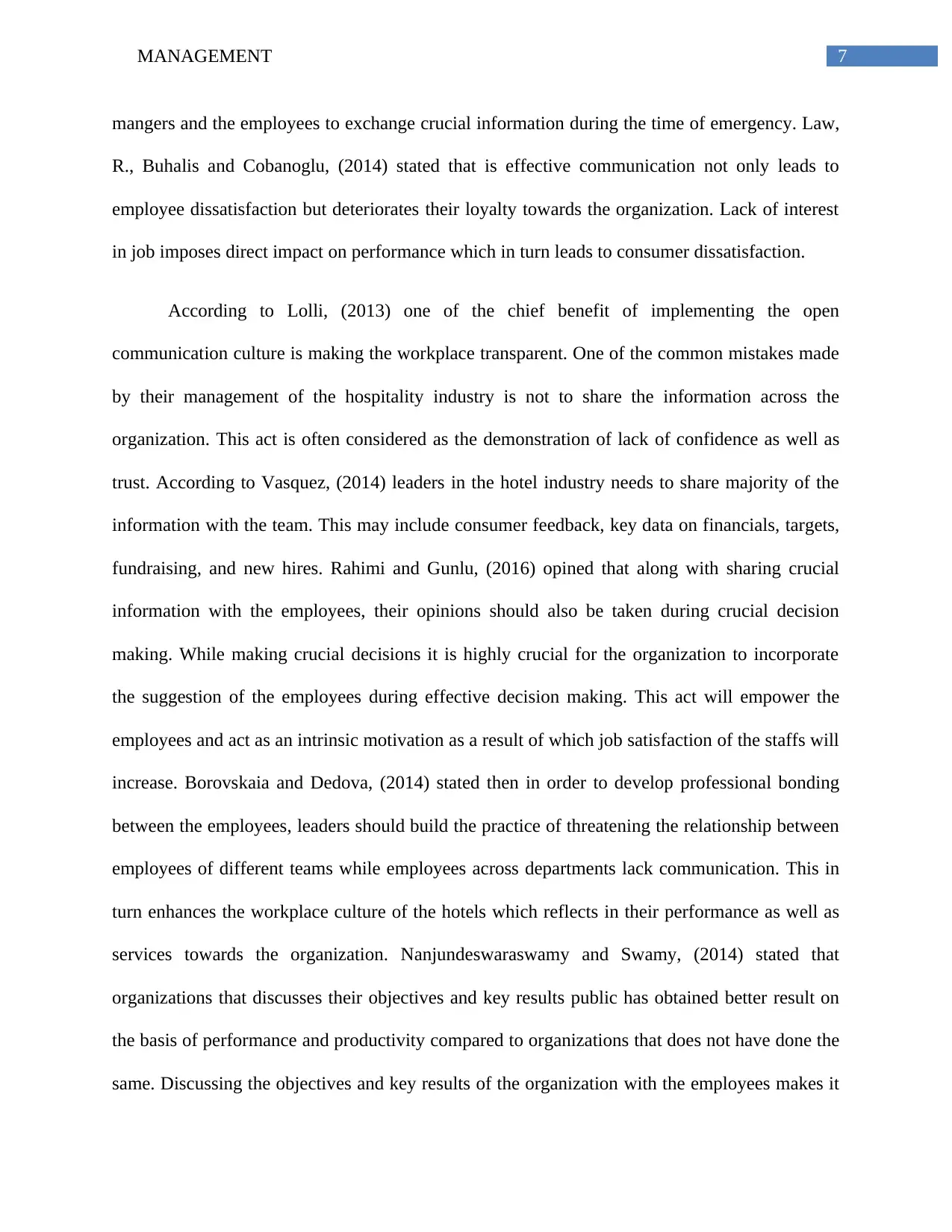
7MANAGEMENT
mangers and the employees to exchange crucial information during the time of emergency. Law,
R., Buhalis and Cobanoglu, (2014) stated that is effective communication not only leads to
employee dissatisfaction but deteriorates their loyalty towards the organization. Lack of interest
in job imposes direct impact on performance which in turn leads to consumer dissatisfaction.
According to Lolli, (2013) one of the chief benefit of implementing the open
communication culture is making the workplace transparent. One of the common mistakes made
by their management of the hospitality industry is not to share the information across the
organization. This act is often considered as the demonstration of lack of confidence as well as
trust. According to Vasquez, (2014) leaders in the hotel industry needs to share majority of the
information with the team. This may include consumer feedback, key data on financials, targets,
fundraising, and new hires. Rahimi and Gunlu, (2016) opined that along with sharing crucial
information with the employees, their opinions should also be taken during crucial decision
making. While making crucial decisions it is highly crucial for the organization to incorporate
the suggestion of the employees during effective decision making. This act will empower the
employees and act as an intrinsic motivation as a result of which job satisfaction of the staffs will
increase. Borovskaia and Dedova, (2014) stated then in order to develop professional bonding
between the employees, leaders should build the practice of threatening the relationship between
employees of different teams while employees across departments lack communication. This in
turn enhances the workplace culture of the hotels which reflects in their performance as well as
services towards the organization. Nanjundeswaraswamy and Swamy, (2014) stated that
organizations that discusses their objectives and key results public has obtained better result on
the basis of performance and productivity compared to organizations that does not have done the
same. Discussing the objectives and key results of the organization with the employees makes it
mangers and the employees to exchange crucial information during the time of emergency. Law,
R., Buhalis and Cobanoglu, (2014) stated that is effective communication not only leads to
employee dissatisfaction but deteriorates their loyalty towards the organization. Lack of interest
in job imposes direct impact on performance which in turn leads to consumer dissatisfaction.
According to Lolli, (2013) one of the chief benefit of implementing the open
communication culture is making the workplace transparent. One of the common mistakes made
by their management of the hospitality industry is not to share the information across the
organization. This act is often considered as the demonstration of lack of confidence as well as
trust. According to Vasquez, (2014) leaders in the hotel industry needs to share majority of the
information with the team. This may include consumer feedback, key data on financials, targets,
fundraising, and new hires. Rahimi and Gunlu, (2016) opined that along with sharing crucial
information with the employees, their opinions should also be taken during crucial decision
making. While making crucial decisions it is highly crucial for the organization to incorporate
the suggestion of the employees during effective decision making. This act will empower the
employees and act as an intrinsic motivation as a result of which job satisfaction of the staffs will
increase. Borovskaia and Dedova, (2014) stated then in order to develop professional bonding
between the employees, leaders should build the practice of threatening the relationship between
employees of different teams while employees across departments lack communication. This in
turn enhances the workplace culture of the hotels which reflects in their performance as well as
services towards the organization. Nanjundeswaraswamy and Swamy, (2014) stated that
organizations that discusses their objectives and key results public has obtained better result on
the basis of performance and productivity compared to organizations that does not have done the
same. Discussing the objectives and key results of the organization with the employees makes it
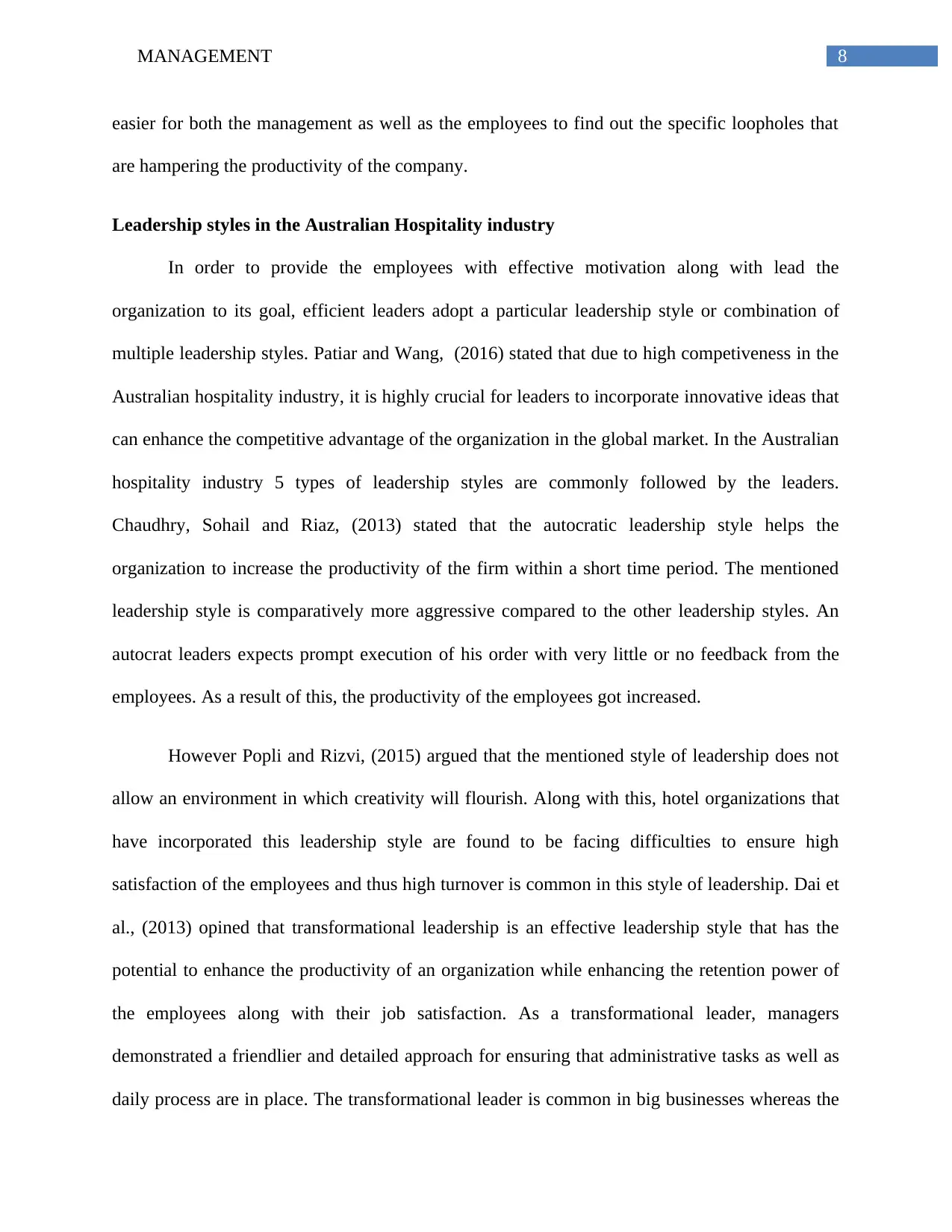
8MANAGEMENT
easier for both the management as well as the employees to find out the specific loopholes that
are hampering the productivity of the company.
Leadership styles in the Australian Hospitality industry
In order to provide the employees with effective motivation along with lead the
organization to its goal, efficient leaders adopt a particular leadership style or combination of
multiple leadership styles. Patiar and Wang, (2016) stated that due to high competiveness in the
Australian hospitality industry, it is highly crucial for leaders to incorporate innovative ideas that
can enhance the competitive advantage of the organization in the global market. In the Australian
hospitality industry 5 types of leadership styles are commonly followed by the leaders.
Chaudhry, Sohail and Riaz, (2013) stated that the autocratic leadership style helps the
organization to increase the productivity of the firm within a short time period. The mentioned
leadership style is comparatively more aggressive compared to the other leadership styles. An
autocrat leaders expects prompt execution of his order with very little or no feedback from the
employees. As a result of this, the productivity of the employees got increased.
However Popli and Rizvi, (2015) argued that the mentioned style of leadership does not
allow an environment in which creativity will flourish. Along with this, hotel organizations that
have incorporated this leadership style are found to be facing difficulties to ensure high
satisfaction of the employees and thus high turnover is common in this style of leadership. Dai et
al., (2013) opined that transformational leadership is an effective leadership style that has the
potential to enhance the productivity of an organization while enhancing the retention power of
the employees along with their job satisfaction. As a transformational leader, managers
demonstrated a friendlier and detailed approach for ensuring that administrative tasks as well as
daily process are in place. The transformational leader is common in big businesses whereas the
easier for both the management as well as the employees to find out the specific loopholes that
are hampering the productivity of the company.
Leadership styles in the Australian Hospitality industry
In order to provide the employees with effective motivation along with lead the
organization to its goal, efficient leaders adopt a particular leadership style or combination of
multiple leadership styles. Patiar and Wang, (2016) stated that due to high competiveness in the
Australian hospitality industry, it is highly crucial for leaders to incorporate innovative ideas that
can enhance the competitive advantage of the organization in the global market. In the Australian
hospitality industry 5 types of leadership styles are commonly followed by the leaders.
Chaudhry, Sohail and Riaz, (2013) stated that the autocratic leadership style helps the
organization to increase the productivity of the firm within a short time period. The mentioned
leadership style is comparatively more aggressive compared to the other leadership styles. An
autocrat leaders expects prompt execution of his order with very little or no feedback from the
employees. As a result of this, the productivity of the employees got increased.
However Popli and Rizvi, (2015) argued that the mentioned style of leadership does not
allow an environment in which creativity will flourish. Along with this, hotel organizations that
have incorporated this leadership style are found to be facing difficulties to ensure high
satisfaction of the employees and thus high turnover is common in this style of leadership. Dai et
al., (2013) opined that transformational leadership is an effective leadership style that has the
potential to enhance the productivity of an organization while enhancing the retention power of
the employees along with their job satisfaction. As a transformational leader, managers
demonstrated a friendlier and detailed approach for ensuring that administrative tasks as well as
daily process are in place. The transformational leader is common in big businesses whereas the
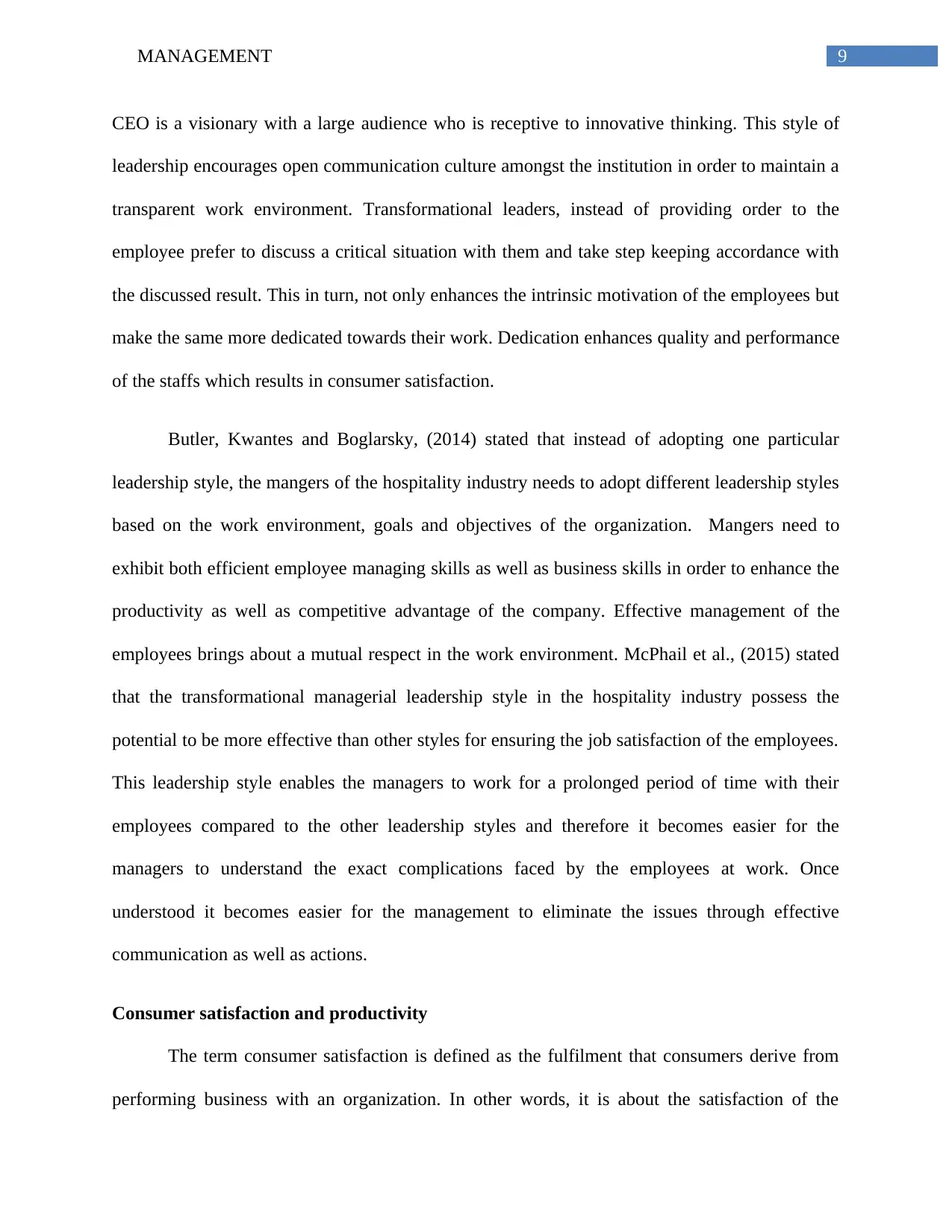
9MANAGEMENT
CEO is a visionary with a large audience who is receptive to innovative thinking. This style of
leadership encourages open communication culture amongst the institution in order to maintain a
transparent work environment. Transformational leaders, instead of providing order to the
employee prefer to discuss a critical situation with them and take step keeping accordance with
the discussed result. This in turn, not only enhances the intrinsic motivation of the employees but
make the same more dedicated towards their work. Dedication enhances quality and performance
of the staffs which results in consumer satisfaction.
Butler, Kwantes and Boglarsky, (2014) stated that instead of adopting one particular
leadership style, the mangers of the hospitality industry needs to adopt different leadership styles
based on the work environment, goals and objectives of the organization. Mangers need to
exhibit both efficient employee managing skills as well as business skills in order to enhance the
productivity as well as competitive advantage of the company. Effective management of the
employees brings about a mutual respect in the work environment. McPhail et al., (2015) stated
that the transformational managerial leadership style in the hospitality industry possess the
potential to be more effective than other styles for ensuring the job satisfaction of the employees.
This leadership style enables the managers to work for a prolonged period of time with their
employees compared to the other leadership styles and therefore it becomes easier for the
managers to understand the exact complications faced by the employees at work. Once
understood it becomes easier for the management to eliminate the issues through effective
communication as well as actions.
Consumer satisfaction and productivity
The term consumer satisfaction is defined as the fulfilment that consumers derive from
performing business with an organization. In other words, it is about the satisfaction of the
CEO is a visionary with a large audience who is receptive to innovative thinking. This style of
leadership encourages open communication culture amongst the institution in order to maintain a
transparent work environment. Transformational leaders, instead of providing order to the
employee prefer to discuss a critical situation with them and take step keeping accordance with
the discussed result. This in turn, not only enhances the intrinsic motivation of the employees but
make the same more dedicated towards their work. Dedication enhances quality and performance
of the staffs which results in consumer satisfaction.
Butler, Kwantes and Boglarsky, (2014) stated that instead of adopting one particular
leadership style, the mangers of the hospitality industry needs to adopt different leadership styles
based on the work environment, goals and objectives of the organization. Mangers need to
exhibit both efficient employee managing skills as well as business skills in order to enhance the
productivity as well as competitive advantage of the company. Effective management of the
employees brings about a mutual respect in the work environment. McPhail et al., (2015) stated
that the transformational managerial leadership style in the hospitality industry possess the
potential to be more effective than other styles for ensuring the job satisfaction of the employees.
This leadership style enables the managers to work for a prolonged period of time with their
employees compared to the other leadership styles and therefore it becomes easier for the
managers to understand the exact complications faced by the employees at work. Once
understood it becomes easier for the management to eliminate the issues through effective
communication as well as actions.
Consumer satisfaction and productivity
The term consumer satisfaction is defined as the fulfilment that consumers derive from
performing business with an organization. In other words, it is about the satisfaction of the
Secure Best Marks with AI Grader
Need help grading? Try our AI Grader for instant feedback on your assignments.
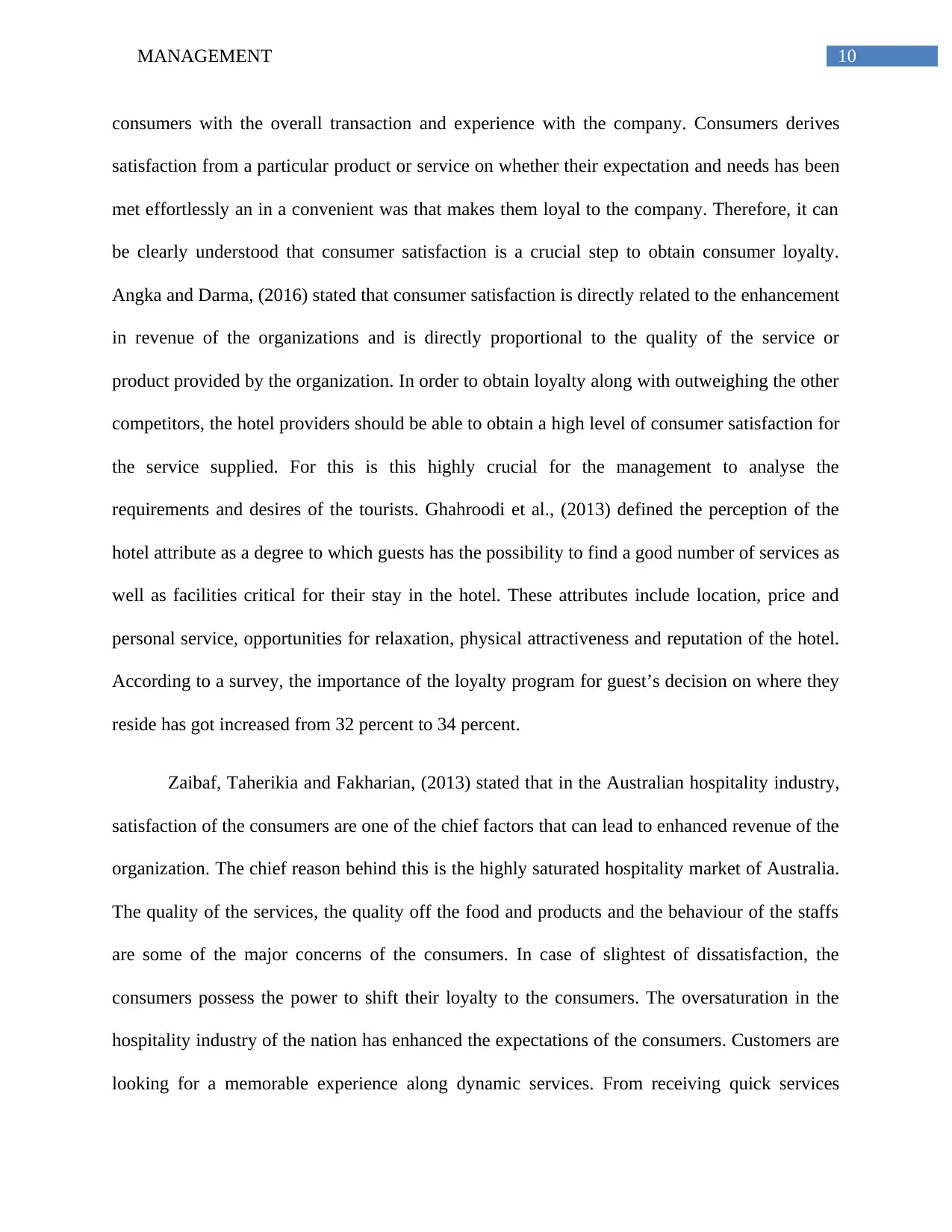
10MANAGEMENT
consumers with the overall transaction and experience with the company. Consumers derives
satisfaction from a particular product or service on whether their expectation and needs has been
met effortlessly an in a convenient was that makes them loyal to the company. Therefore, it can
be clearly understood that consumer satisfaction is a crucial step to obtain consumer loyalty.
Angka and Darma, (2016) stated that consumer satisfaction is directly related to the enhancement
in revenue of the organizations and is directly proportional to the quality of the service or
product provided by the organization. In order to obtain loyalty along with outweighing the other
competitors, the hotel providers should be able to obtain a high level of consumer satisfaction for
the service supplied. For this is this highly crucial for the management to analyse the
requirements and desires of the tourists. Ghahroodi et al., (2013) defined the perception of the
hotel attribute as a degree to which guests has the possibility to find a good number of services as
well as facilities critical for their stay in the hotel. These attributes include location, price and
personal service, opportunities for relaxation, physical attractiveness and reputation of the hotel.
According to a survey, the importance of the loyalty program for guest’s decision on where they
reside has got increased from 32 percent to 34 percent.
Zaibaf, Taherikia and Fakharian, (2013) stated that in the Australian hospitality industry,
satisfaction of the consumers are one of the chief factors that can lead to enhanced revenue of the
organization. The chief reason behind this is the highly saturated hospitality market of Australia.
The quality of the services, the quality off the food and products and the behaviour of the staffs
are some of the major concerns of the consumers. In case of slightest of dissatisfaction, the
consumers possess the power to shift their loyalty to the consumers. The oversaturation in the
hospitality industry of the nation has enhanced the expectations of the consumers. Customers are
looking for a memorable experience along dynamic services. From receiving quick services
consumers with the overall transaction and experience with the company. Consumers derives
satisfaction from a particular product or service on whether their expectation and needs has been
met effortlessly an in a convenient was that makes them loyal to the company. Therefore, it can
be clearly understood that consumer satisfaction is a crucial step to obtain consumer loyalty.
Angka and Darma, (2016) stated that consumer satisfaction is directly related to the enhancement
in revenue of the organizations and is directly proportional to the quality of the service or
product provided by the organization. In order to obtain loyalty along with outweighing the other
competitors, the hotel providers should be able to obtain a high level of consumer satisfaction for
the service supplied. For this is this highly crucial for the management to analyse the
requirements and desires of the tourists. Ghahroodi et al., (2013) defined the perception of the
hotel attribute as a degree to which guests has the possibility to find a good number of services as
well as facilities critical for their stay in the hotel. These attributes include location, price and
personal service, opportunities for relaxation, physical attractiveness and reputation of the hotel.
According to a survey, the importance of the loyalty program for guest’s decision on where they
reside has got increased from 32 percent to 34 percent.
Zaibaf, Taherikia and Fakharian, (2013) stated that in the Australian hospitality industry,
satisfaction of the consumers are one of the chief factors that can lead to enhanced revenue of the
organization. The chief reason behind this is the highly saturated hospitality market of Australia.
The quality of the services, the quality off the food and products and the behaviour of the staffs
are some of the major concerns of the consumers. In case of slightest of dissatisfaction, the
consumers possess the power to shift their loyalty to the consumers. The oversaturation in the
hospitality industry of the nation has enhanced the expectations of the consumers. Customers are
looking for a memorable experience along dynamic services. From receiving quick services
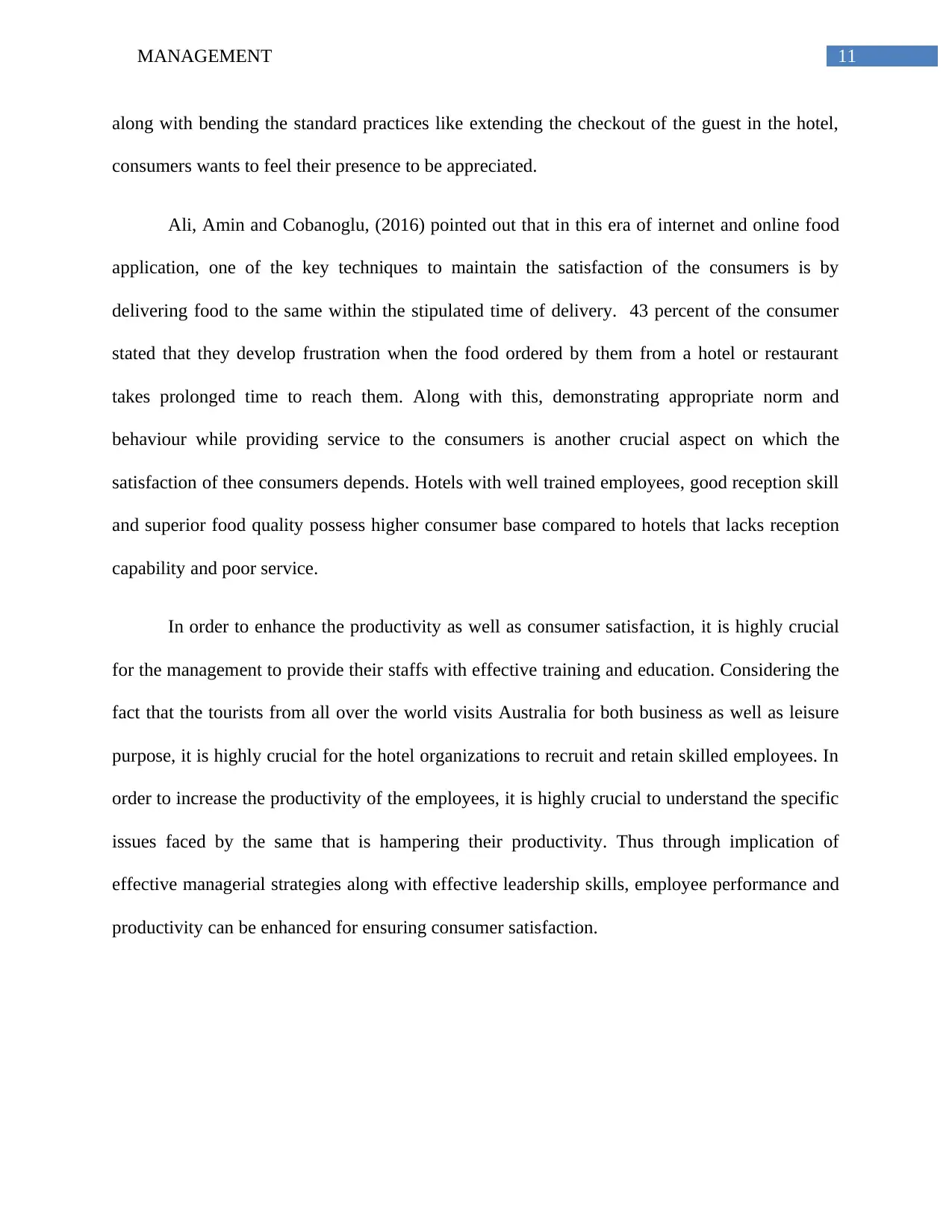
11MANAGEMENT
along with bending the standard practices like extending the checkout of the guest in the hotel,
consumers wants to feel their presence to be appreciated.
Ali, Amin and Cobanoglu, (2016) pointed out that in this era of internet and online food
application, one of the key techniques to maintain the satisfaction of the consumers is by
delivering food to the same within the stipulated time of delivery. 43 percent of the consumer
stated that they develop frustration when the food ordered by them from a hotel or restaurant
takes prolonged time to reach them. Along with this, demonstrating appropriate norm and
behaviour while providing service to the consumers is another crucial aspect on which the
satisfaction of thee consumers depends. Hotels with well trained employees, good reception skill
and superior food quality possess higher consumer base compared to hotels that lacks reception
capability and poor service.
In order to enhance the productivity as well as consumer satisfaction, it is highly crucial
for the management to provide their staffs with effective training and education. Considering the
fact that the tourists from all over the world visits Australia for both business as well as leisure
purpose, it is highly crucial for the hotel organizations to recruit and retain skilled employees. In
order to increase the productivity of the employees, it is highly crucial to understand the specific
issues faced by the same that is hampering their productivity. Thus through implication of
effective managerial strategies along with effective leadership skills, employee performance and
productivity can be enhanced for ensuring consumer satisfaction.
along with bending the standard practices like extending the checkout of the guest in the hotel,
consumers wants to feel their presence to be appreciated.
Ali, Amin and Cobanoglu, (2016) pointed out that in this era of internet and online food
application, one of the key techniques to maintain the satisfaction of the consumers is by
delivering food to the same within the stipulated time of delivery. 43 percent of the consumer
stated that they develop frustration when the food ordered by them from a hotel or restaurant
takes prolonged time to reach them. Along with this, demonstrating appropriate norm and
behaviour while providing service to the consumers is another crucial aspect on which the
satisfaction of thee consumers depends. Hotels with well trained employees, good reception skill
and superior food quality possess higher consumer base compared to hotels that lacks reception
capability and poor service.
In order to enhance the productivity as well as consumer satisfaction, it is highly crucial
for the management to provide their staffs with effective training and education. Considering the
fact that the tourists from all over the world visits Australia for both business as well as leisure
purpose, it is highly crucial for the hotel organizations to recruit and retain skilled employees. In
order to increase the productivity of the employees, it is highly crucial to understand the specific
issues faced by the same that is hampering their productivity. Thus through implication of
effective managerial strategies along with effective leadership skills, employee performance and
productivity can be enhanced for ensuring consumer satisfaction.
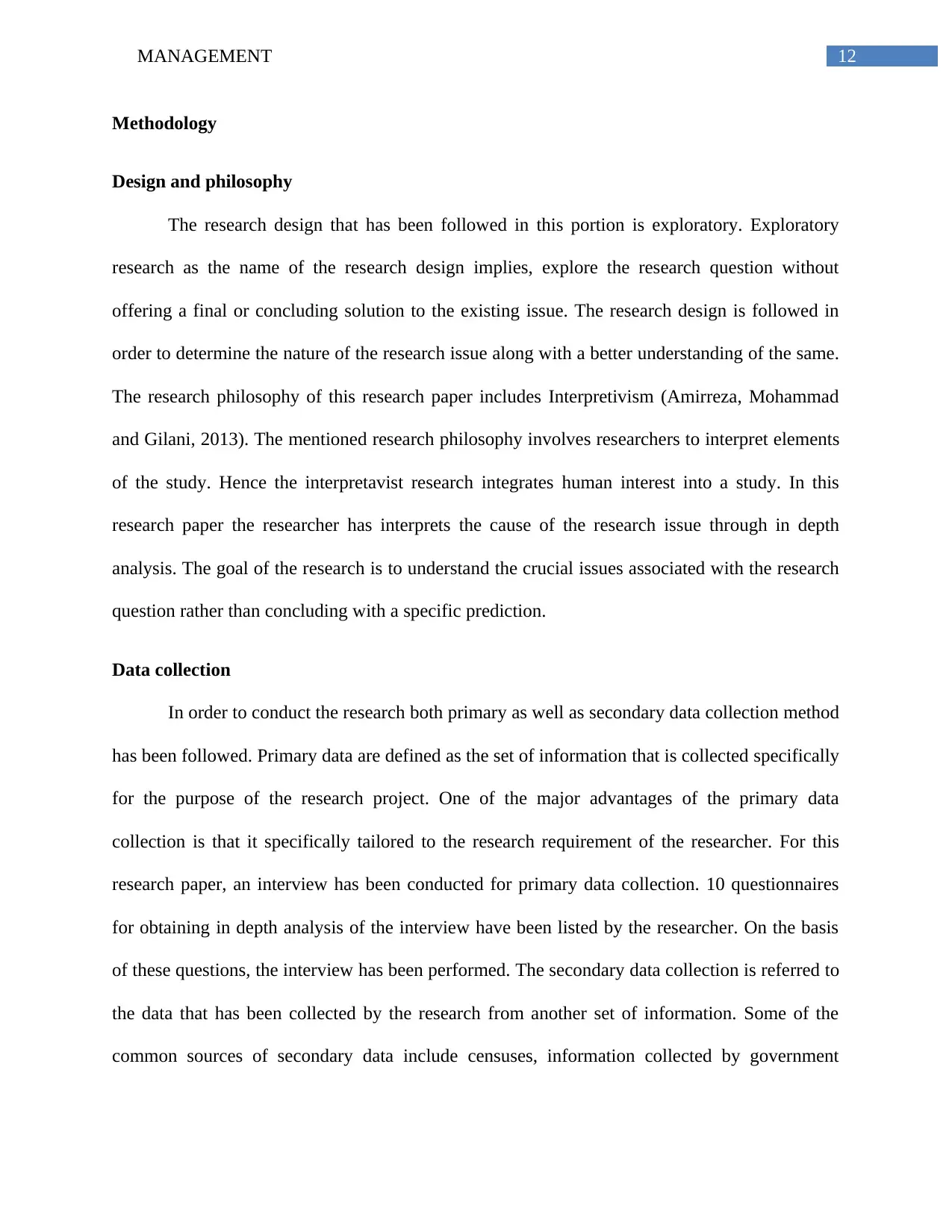
12MANAGEMENT
Methodology
Design and philosophy
The research design that has been followed in this portion is exploratory. Exploratory
research as the name of the research design implies, explore the research question without
offering a final or concluding solution to the existing issue. The research design is followed in
order to determine the nature of the research issue along with a better understanding of the same.
The research philosophy of this research paper includes Interpretivism (Amirreza, Mohammad
and Gilani, 2013). The mentioned research philosophy involves researchers to interpret elements
of the study. Hence the interpretavist research integrates human interest into a study. In this
research paper the researcher has interprets the cause of the research issue through in depth
analysis. The goal of the research is to understand the crucial issues associated with the research
question rather than concluding with a specific prediction.
Data collection
In order to conduct the research both primary as well as secondary data collection method
has been followed. Primary data are defined as the set of information that is collected specifically
for the purpose of the research project. One of the major advantages of the primary data
collection is that it specifically tailored to the research requirement of the researcher. For this
research paper, an interview has been conducted for primary data collection. 10 questionnaires
for obtaining in depth analysis of the interview have been listed by the researcher. On the basis
of these questions, the interview has been performed. The secondary data collection is referred to
the data that has been collected by the research from another set of information. Some of the
common sources of secondary data include censuses, information collected by government
Methodology
Design and philosophy
The research design that has been followed in this portion is exploratory. Exploratory
research as the name of the research design implies, explore the research question without
offering a final or concluding solution to the existing issue. The research design is followed in
order to determine the nature of the research issue along with a better understanding of the same.
The research philosophy of this research paper includes Interpretivism (Amirreza, Mohammad
and Gilani, 2013). The mentioned research philosophy involves researchers to interpret elements
of the study. Hence the interpretavist research integrates human interest into a study. In this
research paper the researcher has interprets the cause of the research issue through in depth
analysis. The goal of the research is to understand the crucial issues associated with the research
question rather than concluding with a specific prediction.
Data collection
In order to conduct the research both primary as well as secondary data collection method
has been followed. Primary data are defined as the set of information that is collected specifically
for the purpose of the research project. One of the major advantages of the primary data
collection is that it specifically tailored to the research requirement of the researcher. For this
research paper, an interview has been conducted for primary data collection. 10 questionnaires
for obtaining in depth analysis of the interview have been listed by the researcher. On the basis
of these questions, the interview has been performed. The secondary data collection is referred to
the data that has been collected by the research from another set of information. Some of the
common sources of secondary data include censuses, information collected by government
Paraphrase This Document
Need a fresh take? Get an instant paraphrase of this document with our AI Paraphraser
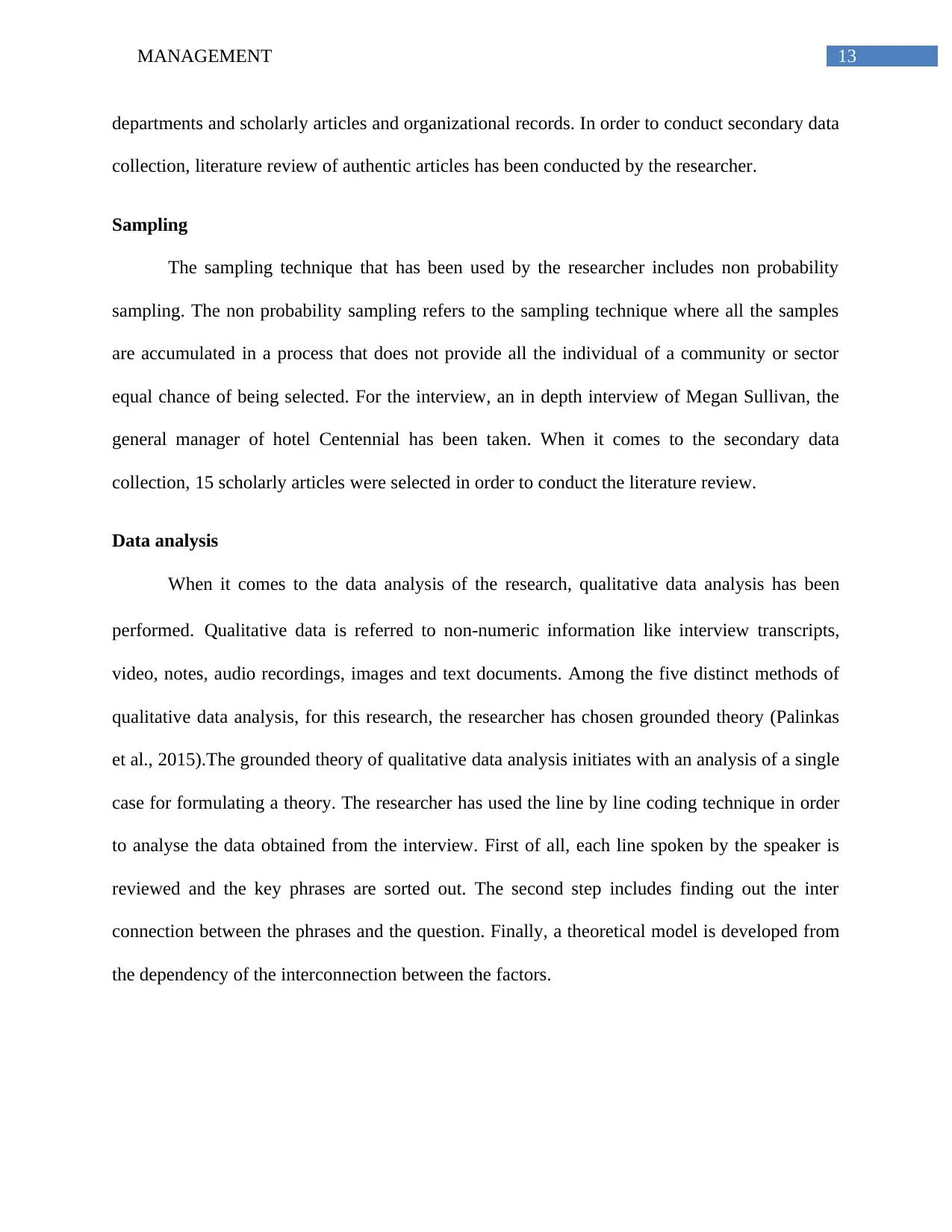
13MANAGEMENT
departments and scholarly articles and organizational records. In order to conduct secondary data
collection, literature review of authentic articles has been conducted by the researcher.
Sampling
The sampling technique that has been used by the researcher includes non probability
sampling. The non probability sampling refers to the sampling technique where all the samples
are accumulated in a process that does not provide all the individual of a community or sector
equal chance of being selected. For the interview, an in depth interview of Megan Sullivan, the
general manager of hotel Centennial has been taken. When it comes to the secondary data
collection, 15 scholarly articles were selected in order to conduct the literature review.
Data analysis
When it comes to the data analysis of the research, qualitative data analysis has been
performed. Qualitative data is referred to non-numeric information like interview transcripts,
video, notes, audio recordings, images and text documents. Among the five distinct methods of
qualitative data analysis, for this research, the researcher has chosen grounded theory (Palinkas
et al., 2015).The grounded theory of qualitative data analysis initiates with an analysis of a single
case for formulating a theory. The researcher has used the line by line coding technique in order
to analyse the data obtained from the interview. First of all, each line spoken by the speaker is
reviewed and the key phrases are sorted out. The second step includes finding out the inter
connection between the phrases and the question. Finally, a theoretical model is developed from
the dependency of the interconnection between the factors.
departments and scholarly articles and organizational records. In order to conduct secondary data
collection, literature review of authentic articles has been conducted by the researcher.
Sampling
The sampling technique that has been used by the researcher includes non probability
sampling. The non probability sampling refers to the sampling technique where all the samples
are accumulated in a process that does not provide all the individual of a community or sector
equal chance of being selected. For the interview, an in depth interview of Megan Sullivan, the
general manager of hotel Centennial has been taken. When it comes to the secondary data
collection, 15 scholarly articles were selected in order to conduct the literature review.
Data analysis
When it comes to the data analysis of the research, qualitative data analysis has been
performed. Qualitative data is referred to non-numeric information like interview transcripts,
video, notes, audio recordings, images and text documents. Among the five distinct methods of
qualitative data analysis, for this research, the researcher has chosen grounded theory (Palinkas
et al., 2015).The grounded theory of qualitative data analysis initiates with an analysis of a single
case for formulating a theory. The researcher has used the line by line coding technique in order
to analyse the data obtained from the interview. First of all, each line spoken by the speaker is
reviewed and the key phrases are sorted out. The second step includes finding out the inter
connection between the phrases and the question. Finally, a theoretical model is developed from
the dependency of the interconnection between the factors.
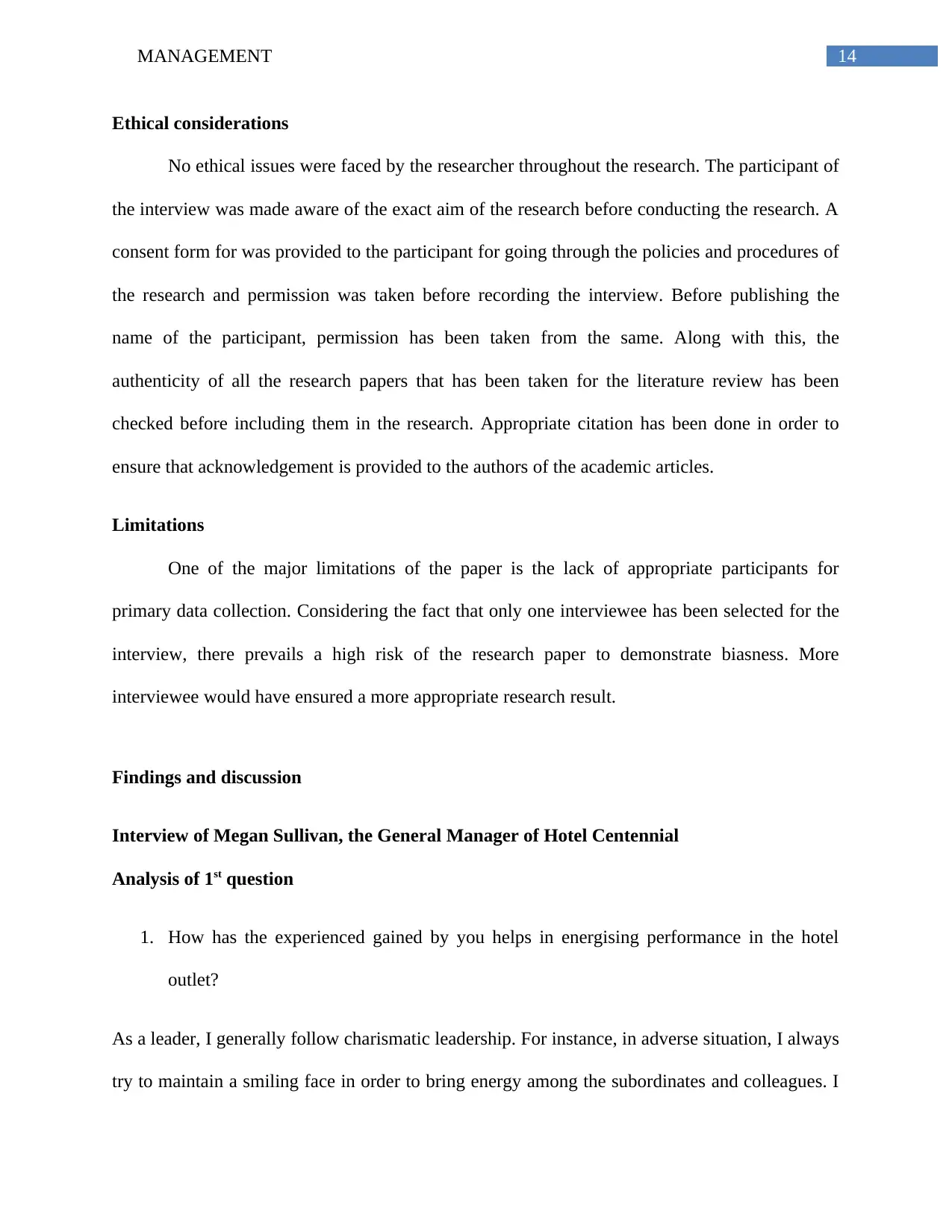
14MANAGEMENT
Ethical considerations
No ethical issues were faced by the researcher throughout the research. The participant of
the interview was made aware of the exact aim of the research before conducting the research. A
consent form for was provided to the participant for going through the policies and procedures of
the research and permission was taken before recording the interview. Before publishing the
name of the participant, permission has been taken from the same. Along with this, the
authenticity of all the research papers that has been taken for the literature review has been
checked before including them in the research. Appropriate citation has been done in order to
ensure that acknowledgement is provided to the authors of the academic articles.
Limitations
One of the major limitations of the paper is the lack of appropriate participants for
primary data collection. Considering the fact that only one interviewee has been selected for the
interview, there prevails a high risk of the research paper to demonstrate biasness. More
interviewee would have ensured a more appropriate research result.
Findings and discussion
Interview of Megan Sullivan, the General Manager of Hotel Centennial
Analysis of 1st question
1. How has the experienced gained by you helps in energising performance in the hotel
outlet?
As a leader, I generally follow charismatic leadership. For instance, in adverse situation, I always
try to maintain a smiling face in order to bring energy among the subordinates and colleagues. I
Ethical considerations
No ethical issues were faced by the researcher throughout the research. The participant of
the interview was made aware of the exact aim of the research before conducting the research. A
consent form for was provided to the participant for going through the policies and procedures of
the research and permission was taken before recording the interview. Before publishing the
name of the participant, permission has been taken from the same. Along with this, the
authenticity of all the research papers that has been taken for the literature review has been
checked before including them in the research. Appropriate citation has been done in order to
ensure that acknowledgement is provided to the authors of the academic articles.
Limitations
One of the major limitations of the paper is the lack of appropriate participants for
primary data collection. Considering the fact that only one interviewee has been selected for the
interview, there prevails a high risk of the research paper to demonstrate biasness. More
interviewee would have ensured a more appropriate research result.
Findings and discussion
Interview of Megan Sullivan, the General Manager of Hotel Centennial
Analysis of 1st question
1. How has the experienced gained by you helps in energising performance in the hotel
outlet?
As a leader, I generally follow charismatic leadership. For instance, in adverse situation, I always
try to maintain a smiling face in order to bring energy among the subordinates and colleagues. I
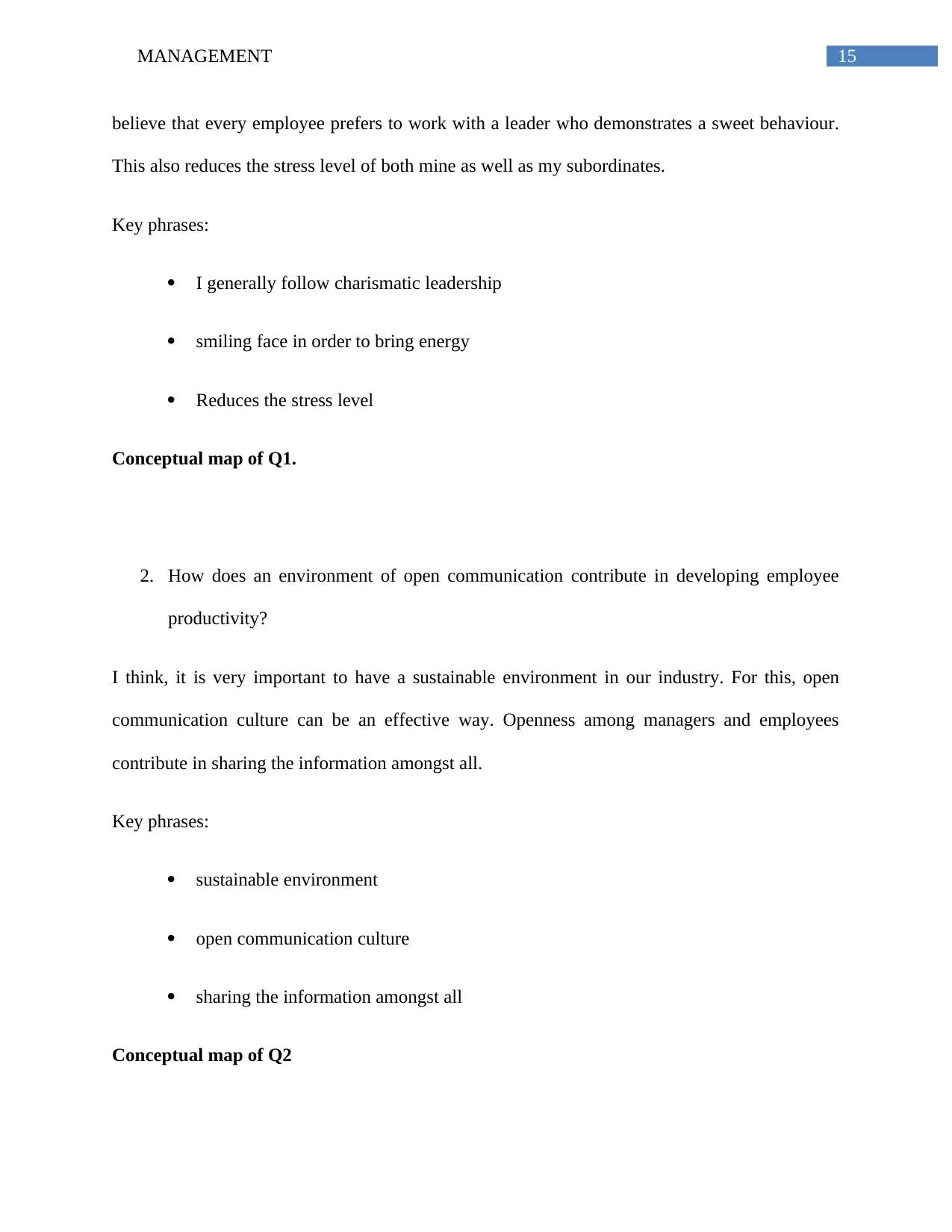
15MANAGEMENT
believe that every employee prefers to work with a leader who demonstrates a sweet behaviour.
This also reduces the stress level of both mine as well as my subordinates.
Key phrases:
I generally follow charismatic leadership
smiling face in order to bring energy
Reduces the stress level
Conceptual map of Q1.
2. How does an environment of open communication contribute in developing employee
productivity?
I think, it is very important to have a sustainable environment in our industry. For this, open
communication culture can be an effective way. Openness among managers and employees
contribute in sharing the information amongst all.
Key phrases:
sustainable environment
open communication culture
sharing the information amongst all
Conceptual map of Q2
believe that every employee prefers to work with a leader who demonstrates a sweet behaviour.
This also reduces the stress level of both mine as well as my subordinates.
Key phrases:
I generally follow charismatic leadership
smiling face in order to bring energy
Reduces the stress level
Conceptual map of Q1.
2. How does an environment of open communication contribute in developing employee
productivity?
I think, it is very important to have a sustainable environment in our industry. For this, open
communication culture can be an effective way. Openness among managers and employees
contribute in sharing the information amongst all.
Key phrases:
sustainable environment
open communication culture
sharing the information amongst all
Conceptual map of Q2
Secure Best Marks with AI Grader
Need help grading? Try our AI Grader for instant feedback on your assignments.
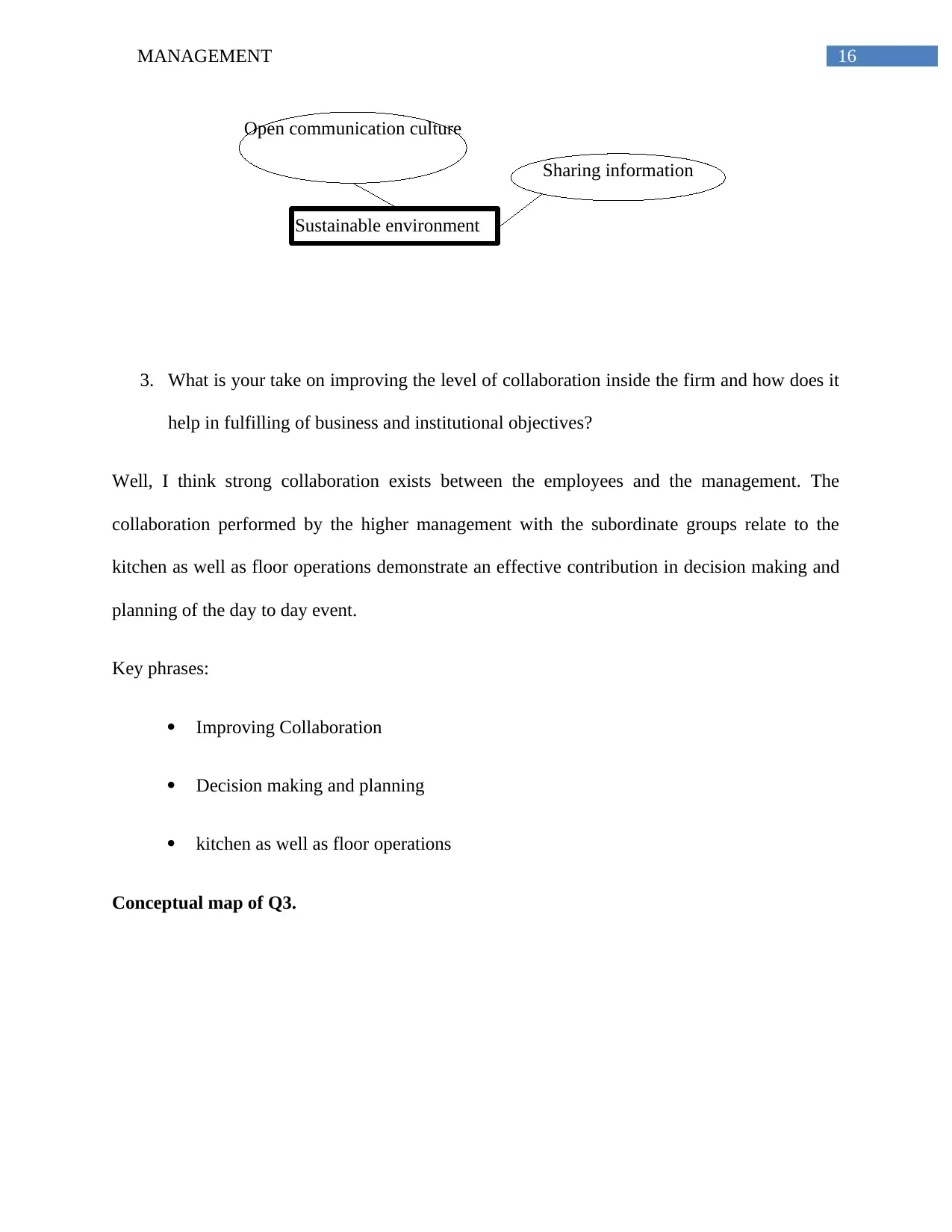
16MANAGEMENT
Sustainable environment
Open communication culture
Sharing information
3. What is your take on improving the level of collaboration inside the firm and how does it
help in fulfilling of business and institutional objectives?
Well, I think strong collaboration exists between the employees and the management. The
collaboration performed by the higher management with the subordinate groups relate to the
kitchen as well as floor operations demonstrate an effective contribution in decision making and
planning of the day to day event.
Key phrases:
Improving Collaboration
Decision making and planning
kitchen as well as floor operations
Conceptual map of Q3.
Sustainable environment
Open communication culture
Sharing information
3. What is your take on improving the level of collaboration inside the firm and how does it
help in fulfilling of business and institutional objectives?
Well, I think strong collaboration exists between the employees and the management. The
collaboration performed by the higher management with the subordinate groups relate to the
kitchen as well as floor operations demonstrate an effective contribution in decision making and
planning of the day to day event.
Key phrases:
Improving Collaboration
Decision making and planning
kitchen as well as floor operations
Conceptual map of Q3.
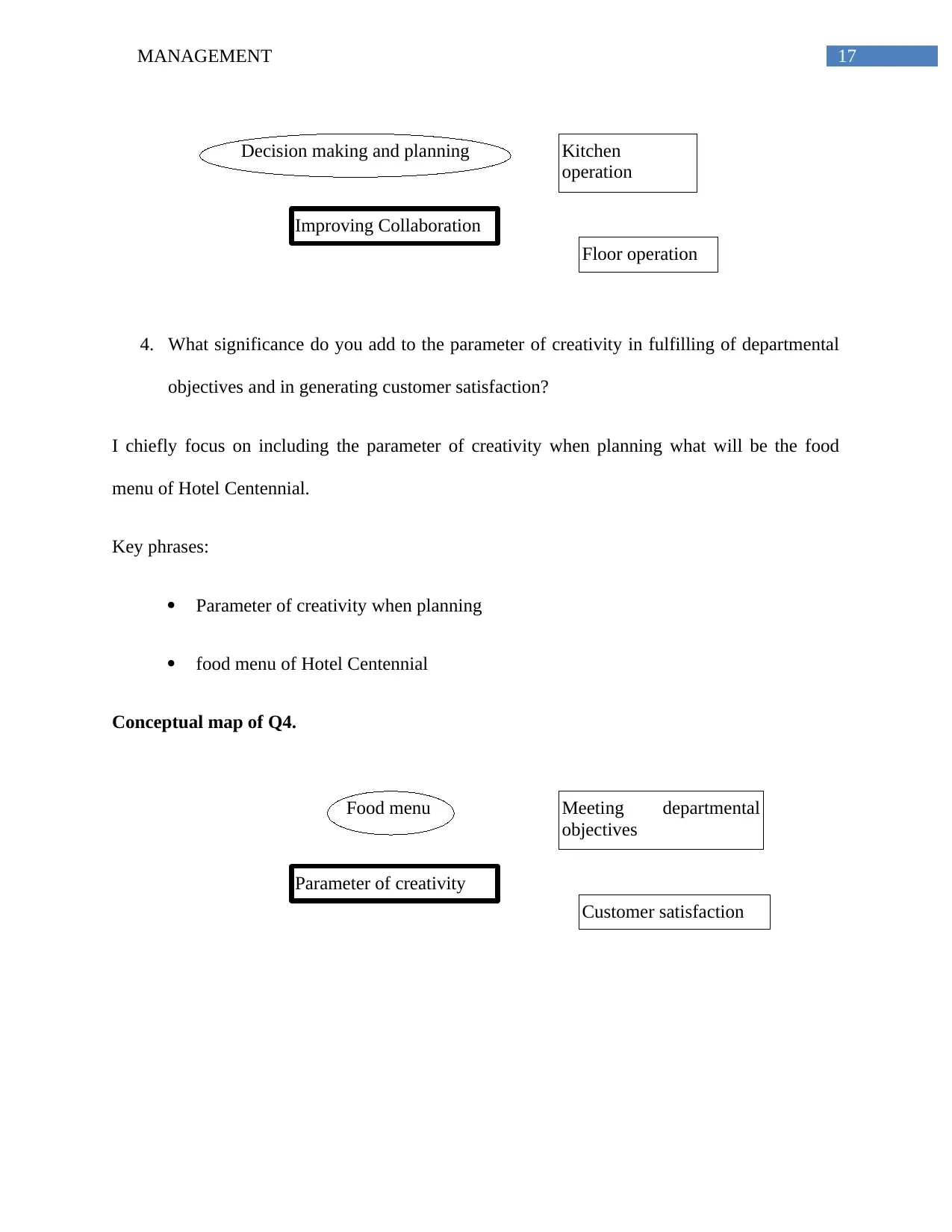
17MANAGEMENT
Improving Collaboration
Kitchen
operation
Floor operation
Decision making and planning
Parameter of creativity
Meeting departmental
objectives
Customer satisfaction
Food menu
4. What significance do you add to the parameter of creativity in fulfilling of departmental
objectives and in generating customer satisfaction?
I chiefly focus on including the parameter of creativity when planning what will be the food
menu of Hotel Centennial.
Key phrases:
Parameter of creativity when planning
food menu of Hotel Centennial
Conceptual map of Q4.
Improving Collaboration
Kitchen
operation
Floor operation
Decision making and planning
Parameter of creativity
Meeting departmental
objectives
Customer satisfaction
Food menu
4. What significance do you add to the parameter of creativity in fulfilling of departmental
objectives and in generating customer satisfaction?
I chiefly focus on including the parameter of creativity when planning what will be the food
menu of Hotel Centennial.
Key phrases:
Parameter of creativity when planning
food menu of Hotel Centennial
Conceptual map of Q4.
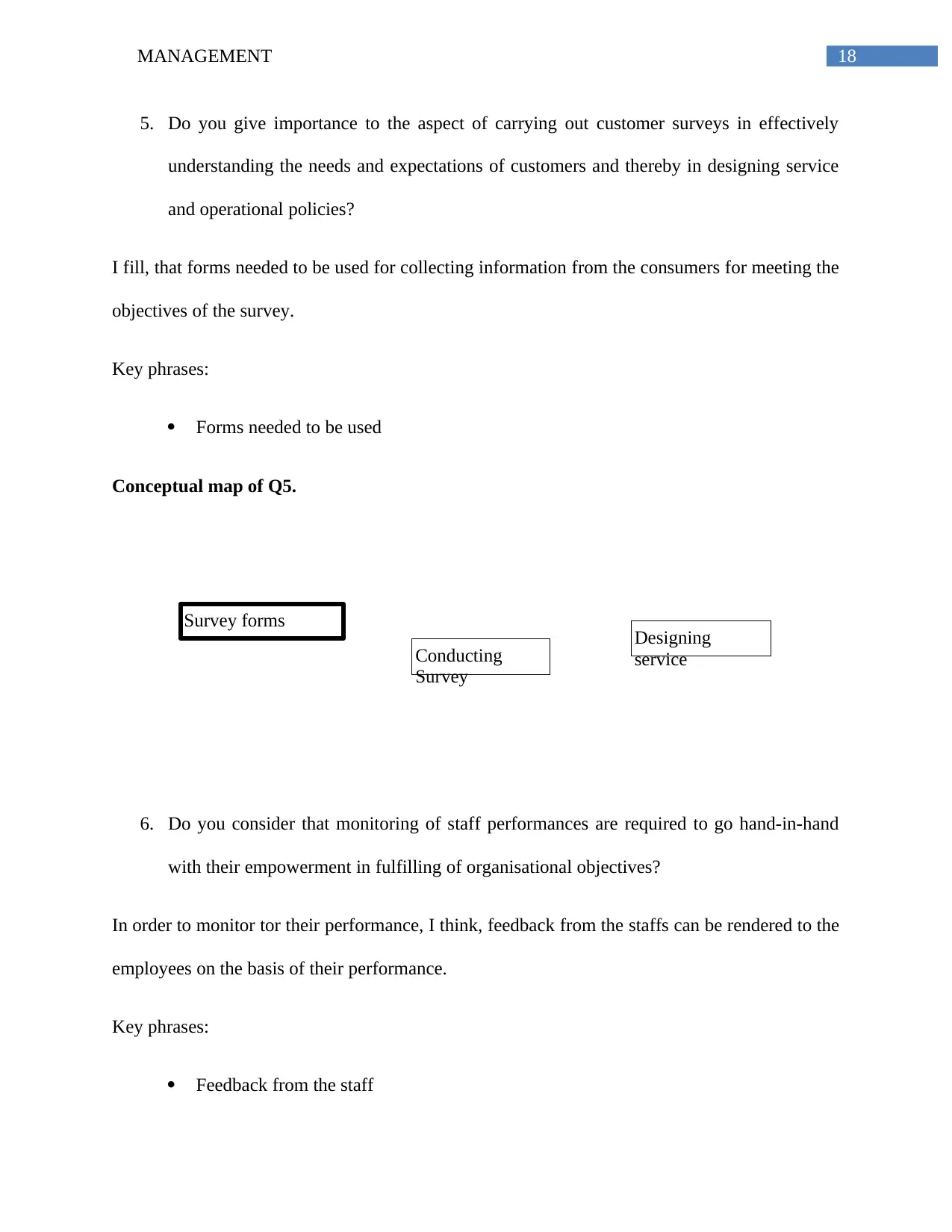
18MANAGEMENT
Survey forms
Conducting
Survey
Designing
service
5. Do you give importance to the aspect of carrying out customer surveys in effectively
understanding the needs and expectations of customers and thereby in designing service
and operational policies?
I fill, that forms needed to be used for collecting information from the consumers for meeting the
objectives of the survey.
Key phrases:
Forms needed to be used
Conceptual map of Q5.
6. Do you consider that monitoring of staff performances are required to go hand-in-hand
with their empowerment in fulfilling of organisational objectives?
In order to monitor tor their performance, I think, feedback from the staffs can be rendered to the
employees on the basis of their performance.
Key phrases:
Feedback from the staff
Survey forms
Conducting
Survey
Designing
service
5. Do you give importance to the aspect of carrying out customer surveys in effectively
understanding the needs and expectations of customers and thereby in designing service
and operational policies?
I fill, that forms needed to be used for collecting information from the consumers for meeting the
objectives of the survey.
Key phrases:
Forms needed to be used
Conceptual map of Q5.
6. Do you consider that monitoring of staff performances are required to go hand-in-hand
with their empowerment in fulfilling of organisational objectives?
In order to monitor tor their performance, I think, feedback from the staffs can be rendered to the
employees on the basis of their performance.
Key phrases:
Feedback from the staff
Paraphrase This Document
Need a fresh take? Get an instant paraphrase of this document with our AI Paraphraser
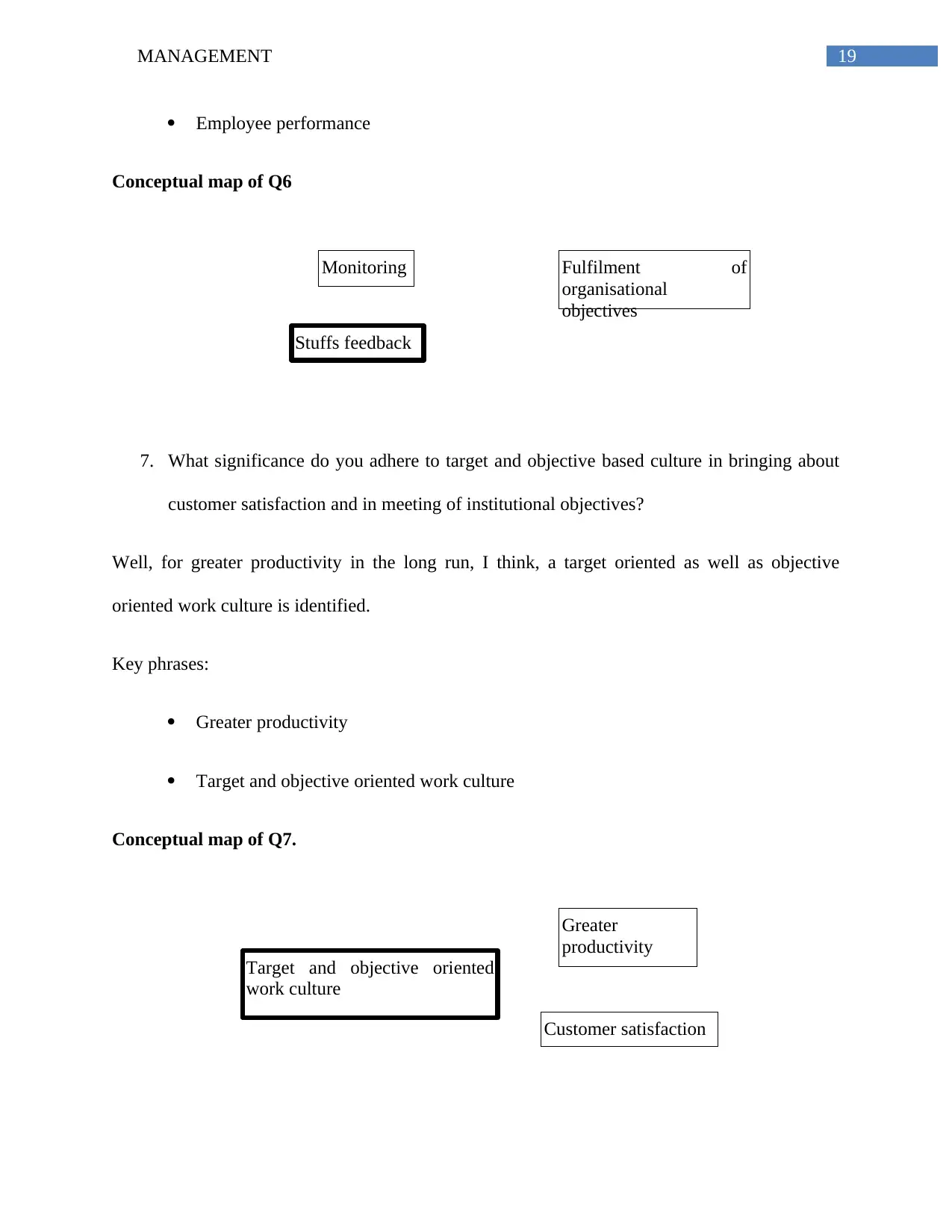
19MANAGEMENT
Stuffs feedback
Fulfilment of
organisational
objectives
Monitoring
Target and objective oriented
work culture
Greater
productivity
Customer satisfaction
Employee performance
Conceptual map of Q6
7. What significance do you adhere to target and objective based culture in bringing about
customer satisfaction and in meeting of institutional objectives?
Well, for greater productivity in the long run, I think, a target oriented as well as objective
oriented work culture is identified.
Key phrases:
Greater productivity
Target and objective oriented work culture
Conceptual map of Q7.
Stuffs feedback
Fulfilment of
organisational
objectives
Monitoring
Target and objective oriented
work culture
Greater
productivity
Customer satisfaction
Employee performance
Conceptual map of Q6
7. What significance do you adhere to target and objective based culture in bringing about
customer satisfaction and in meeting of institutional objectives?
Well, for greater productivity in the long run, I think, a target oriented as well as objective
oriented work culture is identified.
Key phrases:
Greater productivity
Target and objective oriented work culture
Conceptual map of Q7.
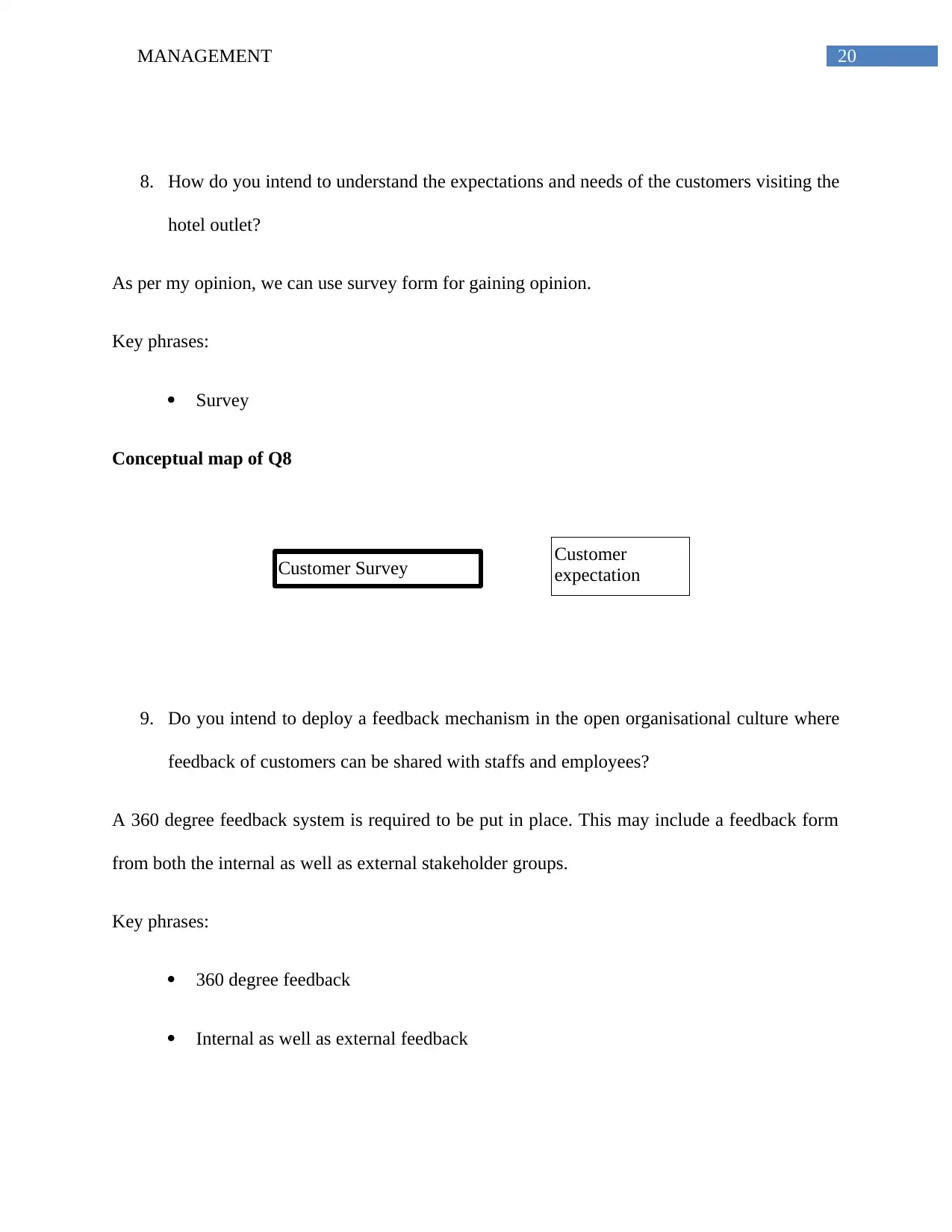
20MANAGEMENT
Customer Survey Customer
expectation
8. How do you intend to understand the expectations and needs of the customers visiting the
hotel outlet?
As per my opinion, we can use survey form for gaining opinion.
Key phrases:
Survey
Conceptual map of Q8
9. Do you intend to deploy a feedback mechanism in the open organisational culture where
feedback of customers can be shared with staffs and employees?
A 360 degree feedback system is required to be put in place. This may include a feedback form
from both the internal as well as external stakeholder groups.
Key phrases:
360 degree feedback
Internal as well as external feedback
Customer Survey Customer
expectation
8. How do you intend to understand the expectations and needs of the customers visiting the
hotel outlet?
As per my opinion, we can use survey form for gaining opinion.
Key phrases:
Survey
Conceptual map of Q8
9. Do you intend to deploy a feedback mechanism in the open organisational culture where
feedback of customers can be shared with staffs and employees?
A 360 degree feedback system is required to be put in place. This may include a feedback form
from both the internal as well as external stakeholder groups.
Key phrases:
360 degree feedback
Internal as well as external feedback
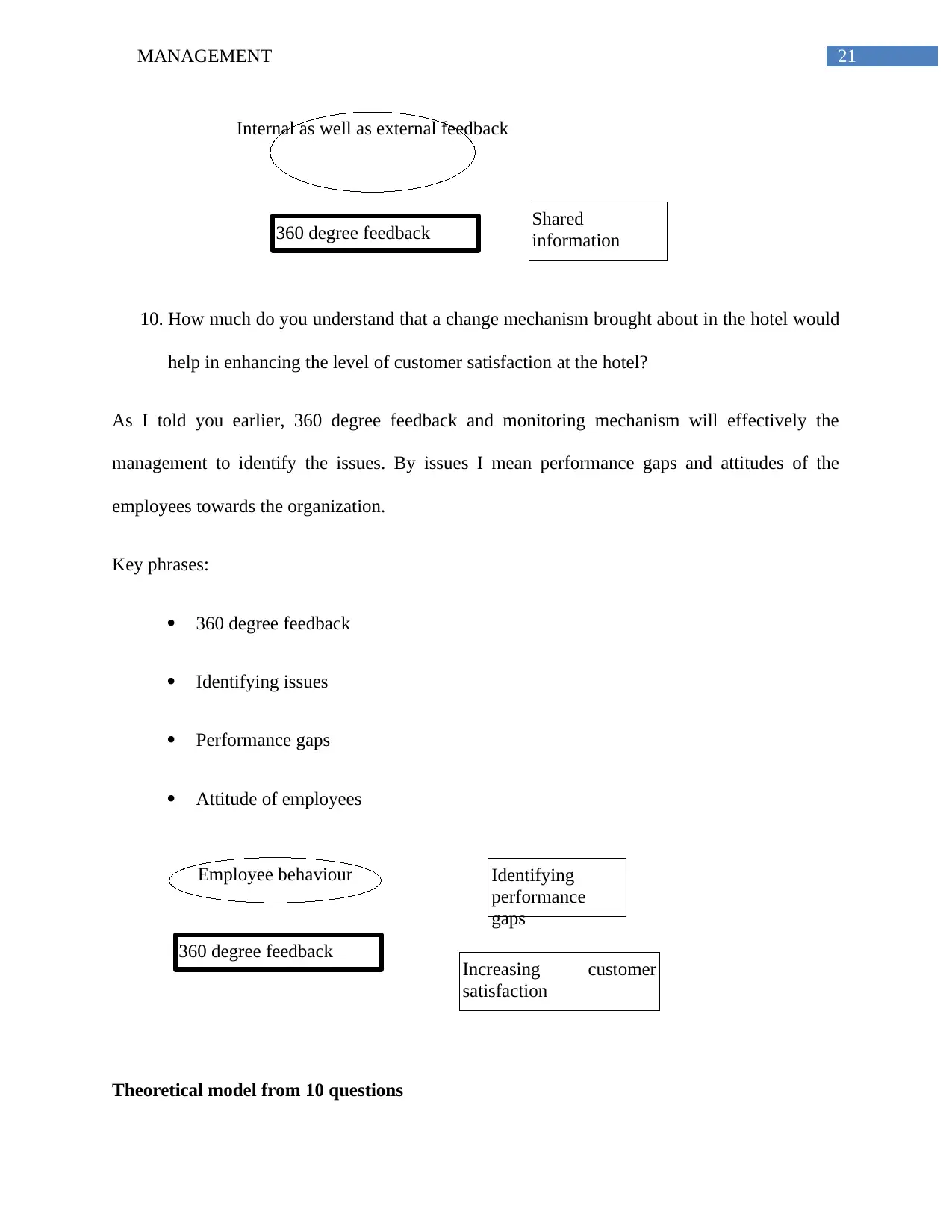
21MANAGEMENT
360 degree feedback Shared
information
Internal as well as external feedback
360 degree feedback Increasing customer
satisfaction
Employee behaviour Identifying
performance
gaps
10. How much do you understand that a change mechanism brought about in the hotel would
help in enhancing the level of customer satisfaction at the hotel?
As I told you earlier, 360 degree feedback and monitoring mechanism will effectively the
management to identify the issues. By issues I mean performance gaps and attitudes of the
employees towards the organization.
Key phrases:
360 degree feedback
Identifying issues
Performance gaps
Attitude of employees
Theoretical model from 10 questions
360 degree feedback Shared
information
Internal as well as external feedback
360 degree feedback Increasing customer
satisfaction
Employee behaviour Identifying
performance
gaps
10. How much do you understand that a change mechanism brought about in the hotel would
help in enhancing the level of customer satisfaction at the hotel?
As I told you earlier, 360 degree feedback and monitoring mechanism will effectively the
management to identify the issues. By issues I mean performance gaps and attitudes of the
employees towards the organization.
Key phrases:
360 degree feedback
Identifying issues
Performance gaps
Attitude of employees
Theoretical model from 10 questions
Secure Best Marks with AI Grader
Need help grading? Try our AI Grader for instant feedback on your assignments.
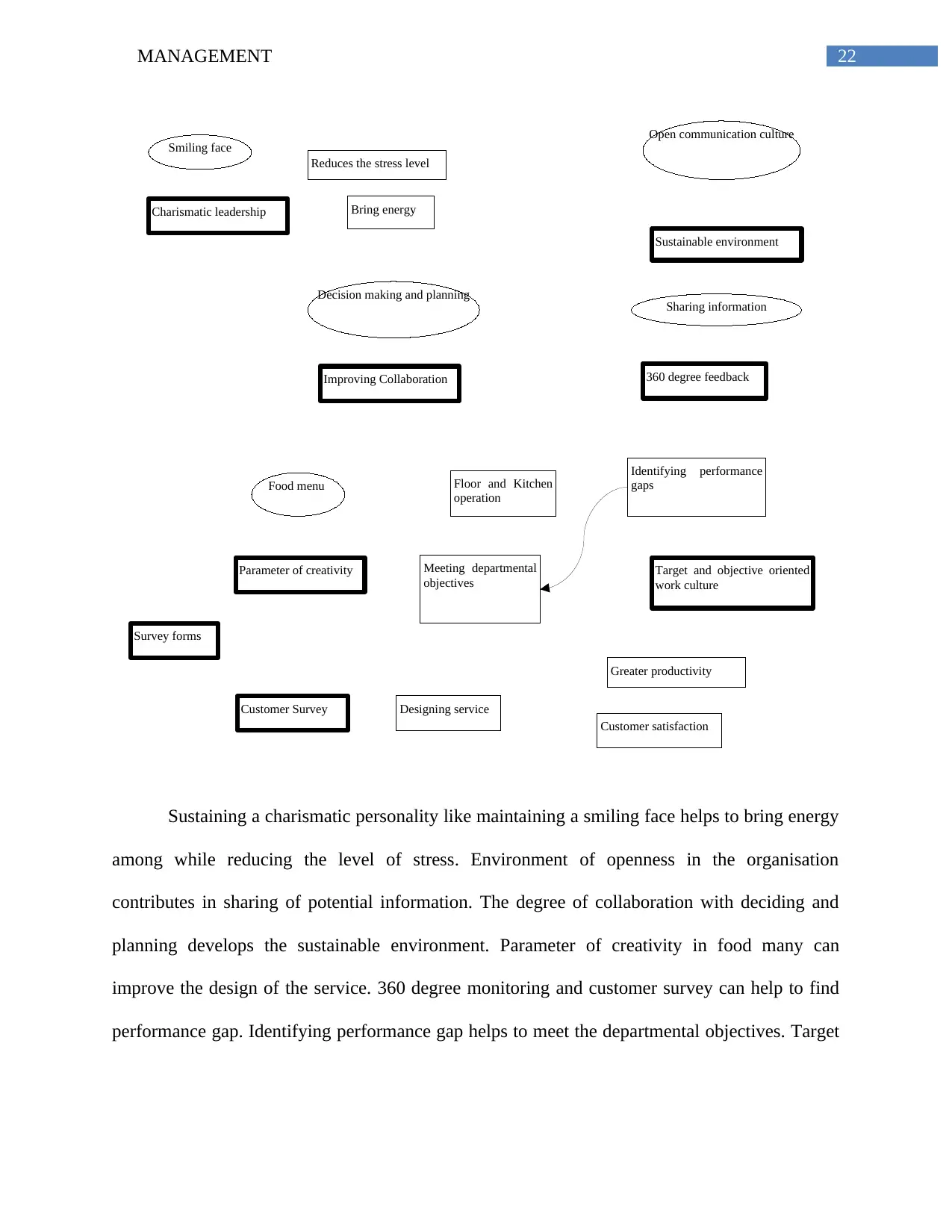
22MANAGEMENT
Charismatic leadership
Reduces the stress level
Bring energy
Smiling face
Sustainable environment
Open communication culture
Sharing information
Improving Collaboration
Floor and Kitchen
operation
Decision making and planning
Parameter of creativity Meeting departmental
objectives
Customer satisfaction
Food menu
Survey forms
Designing service
Target and objective oriented
work culture
Greater productivity
Customer Survey
360 degree feedback
Identifying performance
gaps
Sustaining a charismatic personality like maintaining a smiling face helps to bring energy
among while reducing the level of stress. Environment of openness in the organisation
contributes in sharing of potential information. The degree of collaboration with deciding and
planning develops the sustainable environment. Parameter of creativity in food many can
improve the design of the service. 360 degree monitoring and customer survey can help to find
performance gap. Identifying performance gap helps to meet the departmental objectives. Target
Charismatic leadership
Reduces the stress level
Bring energy
Smiling face
Sustainable environment
Open communication culture
Sharing information
Improving Collaboration
Floor and Kitchen
operation
Decision making and planning
Parameter of creativity Meeting departmental
objectives
Customer satisfaction
Food menu
Survey forms
Designing service
Target and objective oriented
work culture
Greater productivity
Customer Survey
360 degree feedback
Identifying performance
gaps
Sustaining a charismatic personality like maintaining a smiling face helps to bring energy
among while reducing the level of stress. Environment of openness in the organisation
contributes in sharing of potential information. The degree of collaboration with deciding and
planning develops the sustainable environment. Parameter of creativity in food many can
improve the design of the service. 360 degree monitoring and customer survey can help to find
performance gap. Identifying performance gap helps to meet the departmental objectives. Target
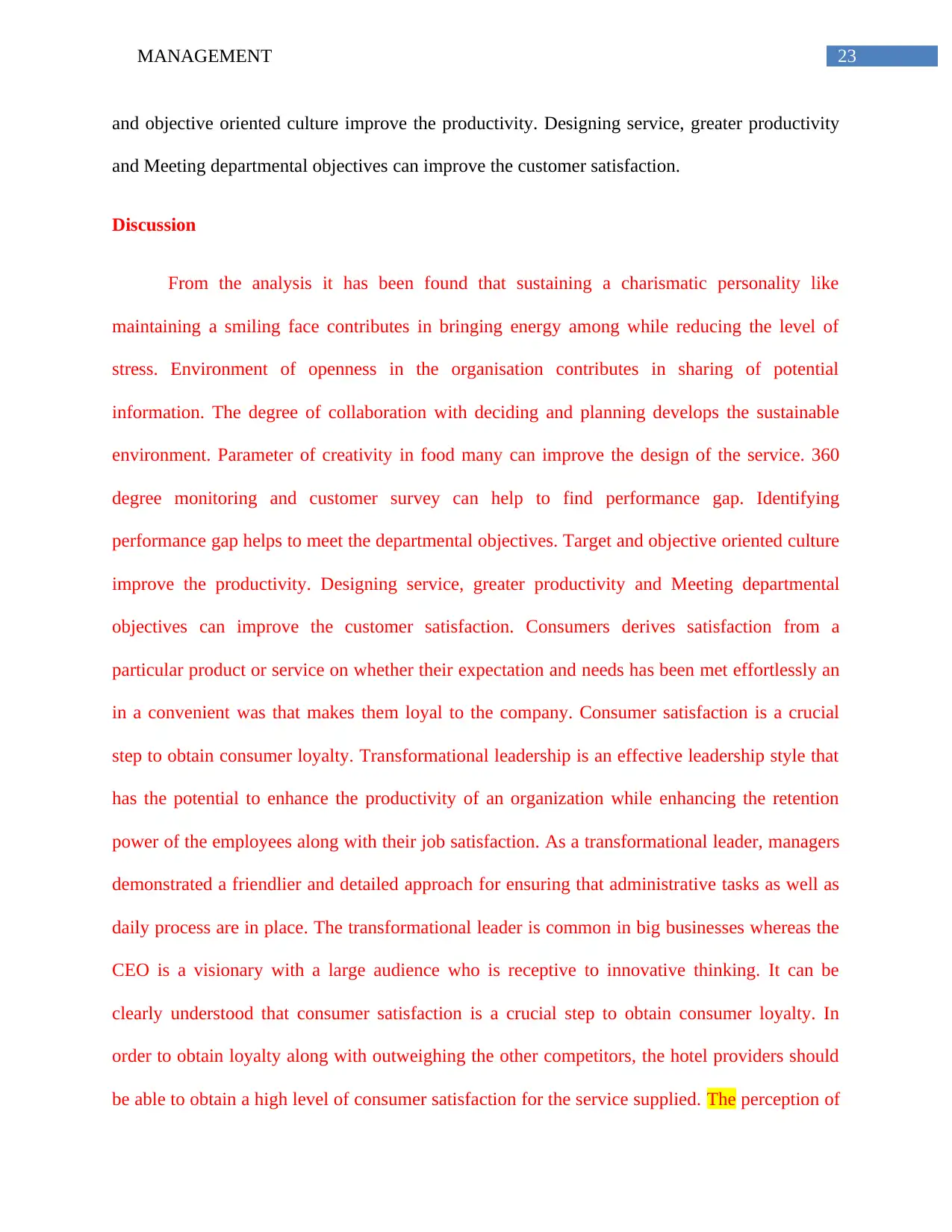
23MANAGEMENT
and objective oriented culture improve the productivity. Designing service, greater productivity
and Meeting departmental objectives can improve the customer satisfaction.
Discussion
From the analysis it has been found that sustaining a charismatic personality like
maintaining a smiling face contributes in bringing energy among while reducing the level of
stress. Environment of openness in the organisation contributes in sharing of potential
information. The degree of collaboration with deciding and planning develops the sustainable
environment. Parameter of creativity in food many can improve the design of the service. 360
degree monitoring and customer survey can help to find performance gap. Identifying
performance gap helps to meet the departmental objectives. Target and objective oriented culture
improve the productivity. Designing service, greater productivity and Meeting departmental
objectives can improve the customer satisfaction. Consumers derives satisfaction from a
particular product or service on whether their expectation and needs has been met effortlessly an
in a convenient was that makes them loyal to the company. Consumer satisfaction is a crucial
step to obtain consumer loyalty. Transformational leadership is an effective leadership style that
has the potential to enhance the productivity of an organization while enhancing the retention
power of the employees along with their job satisfaction. As a transformational leader, managers
demonstrated a friendlier and detailed approach for ensuring that administrative tasks as well as
daily process are in place. The transformational leader is common in big businesses whereas the
CEO is a visionary with a large audience who is receptive to innovative thinking. It can be
clearly understood that consumer satisfaction is a crucial step to obtain consumer loyalty. In
order to obtain loyalty along with outweighing the other competitors, the hotel providers should
be able to obtain a high level of consumer satisfaction for the service supplied. The perception of
and objective oriented culture improve the productivity. Designing service, greater productivity
and Meeting departmental objectives can improve the customer satisfaction.
Discussion
From the analysis it has been found that sustaining a charismatic personality like
maintaining a smiling face contributes in bringing energy among while reducing the level of
stress. Environment of openness in the organisation contributes in sharing of potential
information. The degree of collaboration with deciding and planning develops the sustainable
environment. Parameter of creativity in food many can improve the design of the service. 360
degree monitoring and customer survey can help to find performance gap. Identifying
performance gap helps to meet the departmental objectives. Target and objective oriented culture
improve the productivity. Designing service, greater productivity and Meeting departmental
objectives can improve the customer satisfaction. Consumers derives satisfaction from a
particular product or service on whether their expectation and needs has been met effortlessly an
in a convenient was that makes them loyal to the company. Consumer satisfaction is a crucial
step to obtain consumer loyalty. Transformational leadership is an effective leadership style that
has the potential to enhance the productivity of an organization while enhancing the retention
power of the employees along with their job satisfaction. As a transformational leader, managers
demonstrated a friendlier and detailed approach for ensuring that administrative tasks as well as
daily process are in place. The transformational leader is common in big businesses whereas the
CEO is a visionary with a large audience who is receptive to innovative thinking. It can be
clearly understood that consumer satisfaction is a crucial step to obtain consumer loyalty. In
order to obtain loyalty along with outweighing the other competitors, the hotel providers should
be able to obtain a high level of consumer satisfaction for the service supplied. The perception of
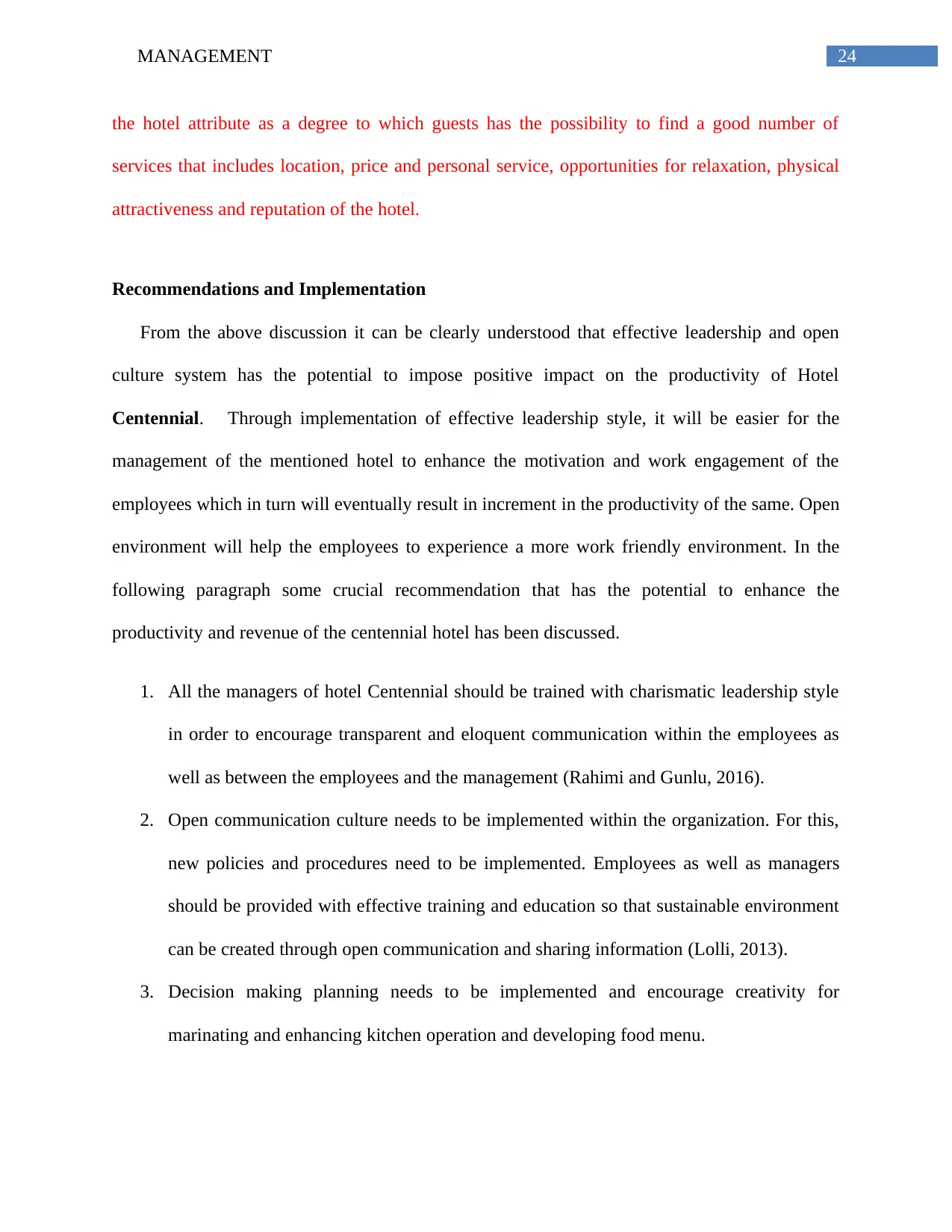
24MANAGEMENT
the hotel attribute as a degree to which guests has the possibility to find a good number of
services that includes location, price and personal service, opportunities for relaxation, physical
attractiveness and reputation of the hotel.
Recommendations and Implementation
From the above discussion it can be clearly understood that effective leadership and open
culture system has the potential to impose positive impact on the productivity of Hotel
Centennial. Through implementation of effective leadership style, it will be easier for the
management of the mentioned hotel to enhance the motivation and work engagement of the
employees which in turn will eventually result in increment in the productivity of the same. Open
environment will help the employees to experience a more work friendly environment. In the
following paragraph some crucial recommendation that has the potential to enhance the
productivity and revenue of the centennial hotel has been discussed.
1. All the managers of hotel Centennial should be trained with charismatic leadership style
in order to encourage transparent and eloquent communication within the employees as
well as between the employees and the management (Rahimi and Gunlu, 2016).
2. Open communication culture needs to be implemented within the organization. For this,
new policies and procedures need to be implemented. Employees as well as managers
should be provided with effective training and education so that sustainable environment
can be created through open communication and sharing information (Lolli, 2013).
3. Decision making planning needs to be implemented and encourage creativity for
marinating and enhancing kitchen operation and developing food menu.
the hotel attribute as a degree to which guests has the possibility to find a good number of
services that includes location, price and personal service, opportunities for relaxation, physical
attractiveness and reputation of the hotel.
Recommendations and Implementation
From the above discussion it can be clearly understood that effective leadership and open
culture system has the potential to impose positive impact on the productivity of Hotel
Centennial. Through implementation of effective leadership style, it will be easier for the
management of the mentioned hotel to enhance the motivation and work engagement of the
employees which in turn will eventually result in increment in the productivity of the same. Open
environment will help the employees to experience a more work friendly environment. In the
following paragraph some crucial recommendation that has the potential to enhance the
productivity and revenue of the centennial hotel has been discussed.
1. All the managers of hotel Centennial should be trained with charismatic leadership style
in order to encourage transparent and eloquent communication within the employees as
well as between the employees and the management (Rahimi and Gunlu, 2016).
2. Open communication culture needs to be implemented within the organization. For this,
new policies and procedures need to be implemented. Employees as well as managers
should be provided with effective training and education so that sustainable environment
can be created through open communication and sharing information (Lolli, 2013).
3. Decision making planning needs to be implemented and encourage creativity for
marinating and enhancing kitchen operation and developing food menu.
Paraphrase This Document
Need a fresh take? Get an instant paraphrase of this document with our AI Paraphraser
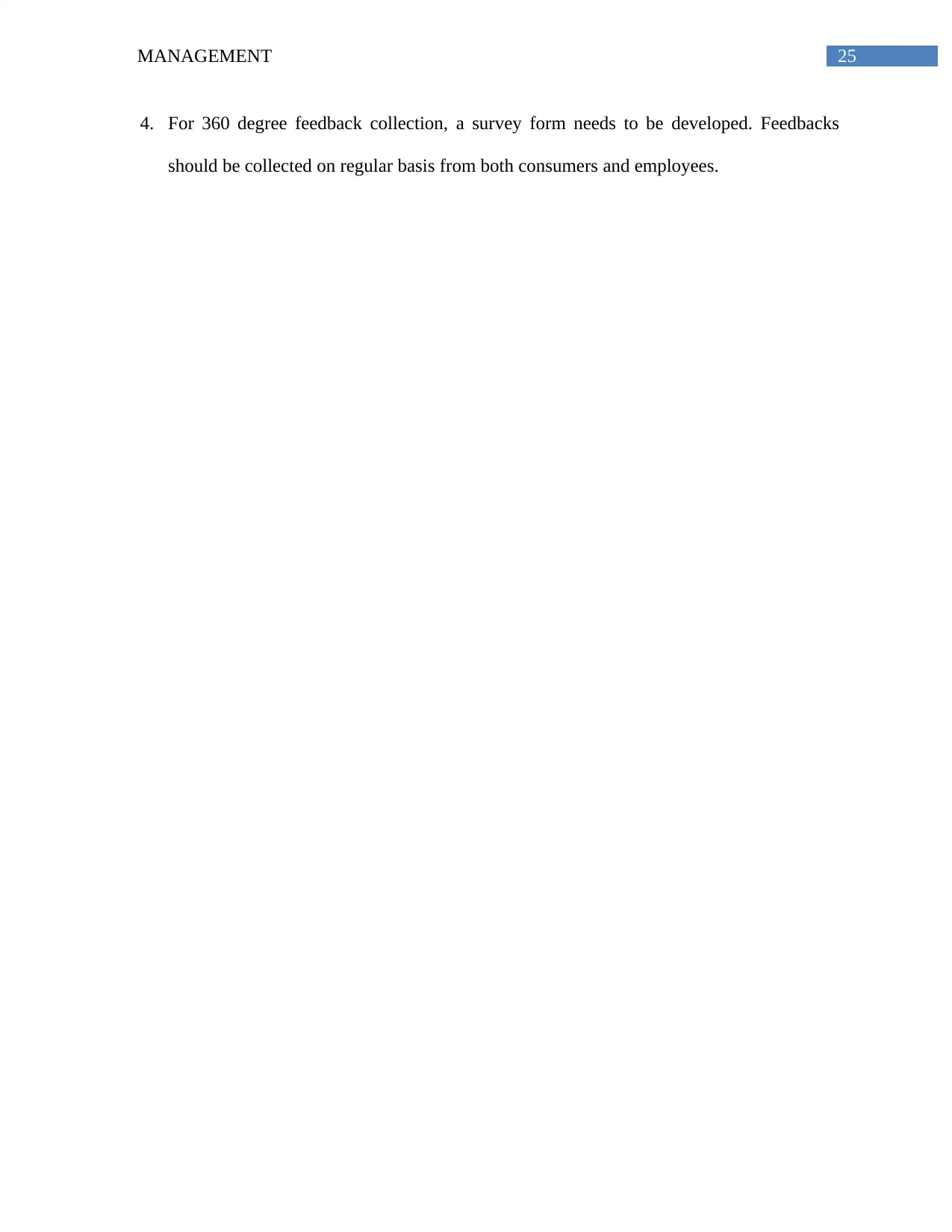
25MANAGEMENT
4. For 360 degree feedback collection, a survey form needs to be developed. Feedbacks
should be collected on regular basis from both consumers and employees.
4. For 360 degree feedback collection, a survey form needs to be developed. Feedbacks
should be collected on regular basis from both consumers and employees.
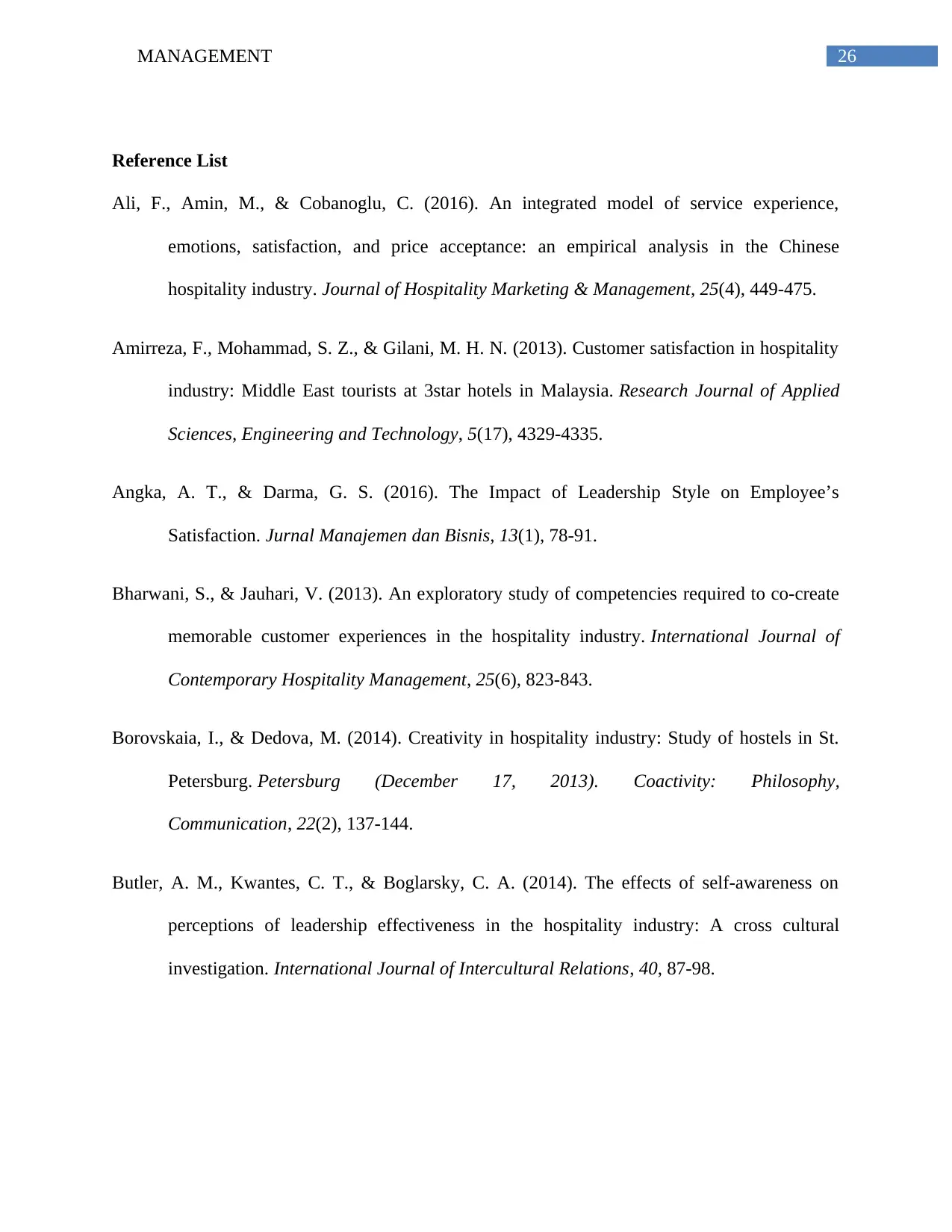
26MANAGEMENT
Reference List
Ali, F., Amin, M., & Cobanoglu, C. (2016). An integrated model of service experience,
emotions, satisfaction, and price acceptance: an empirical analysis in the Chinese
hospitality industry. Journal of Hospitality Marketing & Management, 25(4), 449-475.
Amirreza, F., Mohammad, S. Z., & Gilani, M. H. N. (2013). Customer satisfaction in hospitality
industry: Middle East tourists at 3star hotels in Malaysia. Research Journal of Applied
Sciences, Engineering and Technology, 5(17), 4329-4335.
Angka, A. T., & Darma, G. S. (2016). The Impact of Leadership Style on Employee’s
Satisfaction. Jurnal Manajemen dan Bisnis, 13(1), 78-91.
Bharwani, S., & Jauhari, V. (2013). An exploratory study of competencies required to co-create
memorable customer experiences in the hospitality industry. International Journal of
Contemporary Hospitality Management, 25(6), 823-843.
Borovskaia, I., & Dedova, M. (2014). Creativity in hospitality industry: Study of hostels in St.
Petersburg. Petersburg (December 17, 2013). Coactivity: Philosophy,
Communication, 22(2), 137-144.
Butler, A. M., Kwantes, C. T., & Boglarsky, C. A. (2014). The effects of self-awareness on
perceptions of leadership effectiveness in the hospitality industry: A cross cultural
investigation. International Journal of Intercultural Relations, 40, 87-98.
Reference List
Ali, F., Amin, M., & Cobanoglu, C. (2016). An integrated model of service experience,
emotions, satisfaction, and price acceptance: an empirical analysis in the Chinese
hospitality industry. Journal of Hospitality Marketing & Management, 25(4), 449-475.
Amirreza, F., Mohammad, S. Z., & Gilani, M. H. N. (2013). Customer satisfaction in hospitality
industry: Middle East tourists at 3star hotels in Malaysia. Research Journal of Applied
Sciences, Engineering and Technology, 5(17), 4329-4335.
Angka, A. T., & Darma, G. S. (2016). The Impact of Leadership Style on Employee’s
Satisfaction. Jurnal Manajemen dan Bisnis, 13(1), 78-91.
Bharwani, S., & Jauhari, V. (2013). An exploratory study of competencies required to co-create
memorable customer experiences in the hospitality industry. International Journal of
Contemporary Hospitality Management, 25(6), 823-843.
Borovskaia, I., & Dedova, M. (2014). Creativity in hospitality industry: Study of hostels in St.
Petersburg. Petersburg (December 17, 2013). Coactivity: Philosophy,
Communication, 22(2), 137-144.
Butler, A. M., Kwantes, C. T., & Boglarsky, C. A. (2014). The effects of self-awareness on
perceptions of leadership effectiveness in the hospitality industry: A cross cultural
investigation. International Journal of Intercultural Relations, 40, 87-98.
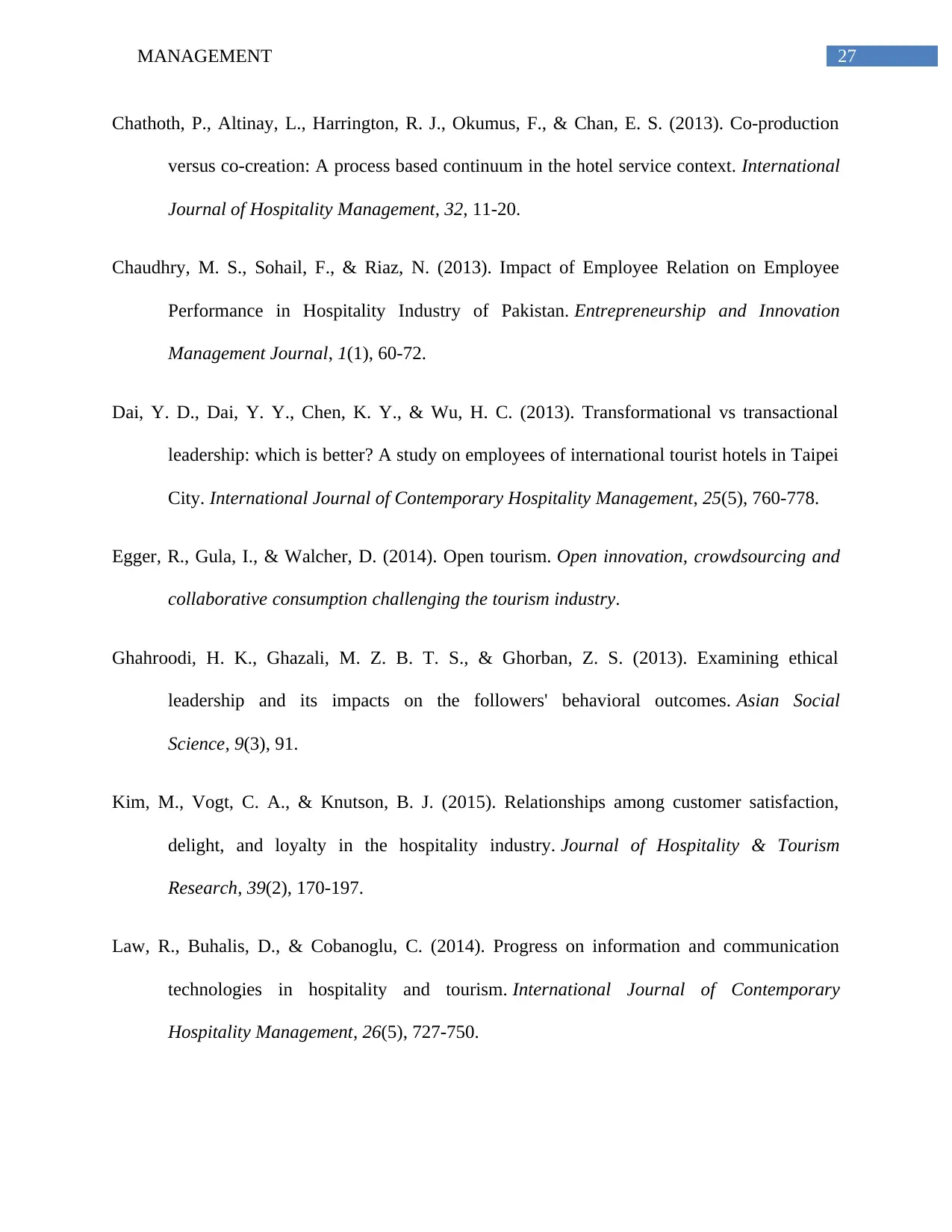
27MANAGEMENT
Chathoth, P., Altinay, L., Harrington, R. J., Okumus, F., & Chan, E. S. (2013). Co-production
versus co-creation: A process based continuum in the hotel service context. International
Journal of Hospitality Management, 32, 11-20.
Chaudhry, M. S., Sohail, F., & Riaz, N. (2013). Impact of Employee Relation on Employee
Performance in Hospitality Industry of Pakistan. Entrepreneurship and Innovation
Management Journal, 1(1), 60-72.
Dai, Y. D., Dai, Y. Y., Chen, K. Y., & Wu, H. C. (2013). Transformational vs transactional
leadership: which is better? A study on employees of international tourist hotels in Taipei
City. International Journal of Contemporary Hospitality Management, 25(5), 760-778.
Egger, R., Gula, I., & Walcher, D. (2014). Open tourism. Open innovation, crowdsourcing and
collaborative consumption challenging the tourism industry.
Ghahroodi, H. K., Ghazali, M. Z. B. T. S., & Ghorban, Z. S. (2013). Examining ethical
leadership and its impacts on the followers' behavioral outcomes. Asian Social
Science, 9(3), 91.
Kim, M., Vogt, C. A., & Knutson, B. J. (2015). Relationships among customer satisfaction,
delight, and loyalty in the hospitality industry. Journal of Hospitality & Tourism
Research, 39(2), 170-197.
Law, R., Buhalis, D., & Cobanoglu, C. (2014). Progress on information and communication
technologies in hospitality and tourism. International Journal of Contemporary
Hospitality Management, 26(5), 727-750.
Chathoth, P., Altinay, L., Harrington, R. J., Okumus, F., & Chan, E. S. (2013). Co-production
versus co-creation: A process based continuum in the hotel service context. International
Journal of Hospitality Management, 32, 11-20.
Chaudhry, M. S., Sohail, F., & Riaz, N. (2013). Impact of Employee Relation on Employee
Performance in Hospitality Industry of Pakistan. Entrepreneurship and Innovation
Management Journal, 1(1), 60-72.
Dai, Y. D., Dai, Y. Y., Chen, K. Y., & Wu, H. C. (2013). Transformational vs transactional
leadership: which is better? A study on employees of international tourist hotels in Taipei
City. International Journal of Contemporary Hospitality Management, 25(5), 760-778.
Egger, R., Gula, I., & Walcher, D. (2014). Open tourism. Open innovation, crowdsourcing and
collaborative consumption challenging the tourism industry.
Ghahroodi, H. K., Ghazali, M. Z. B. T. S., & Ghorban, Z. S. (2013). Examining ethical
leadership and its impacts on the followers' behavioral outcomes. Asian Social
Science, 9(3), 91.
Kim, M., Vogt, C. A., & Knutson, B. J. (2015). Relationships among customer satisfaction,
delight, and loyalty in the hospitality industry. Journal of Hospitality & Tourism
Research, 39(2), 170-197.
Law, R., Buhalis, D., & Cobanoglu, C. (2014). Progress on information and communication
technologies in hospitality and tourism. International Journal of Contemporary
Hospitality Management, 26(5), 727-750.
Secure Best Marks with AI Grader
Need help grading? Try our AI Grader for instant feedback on your assignments.
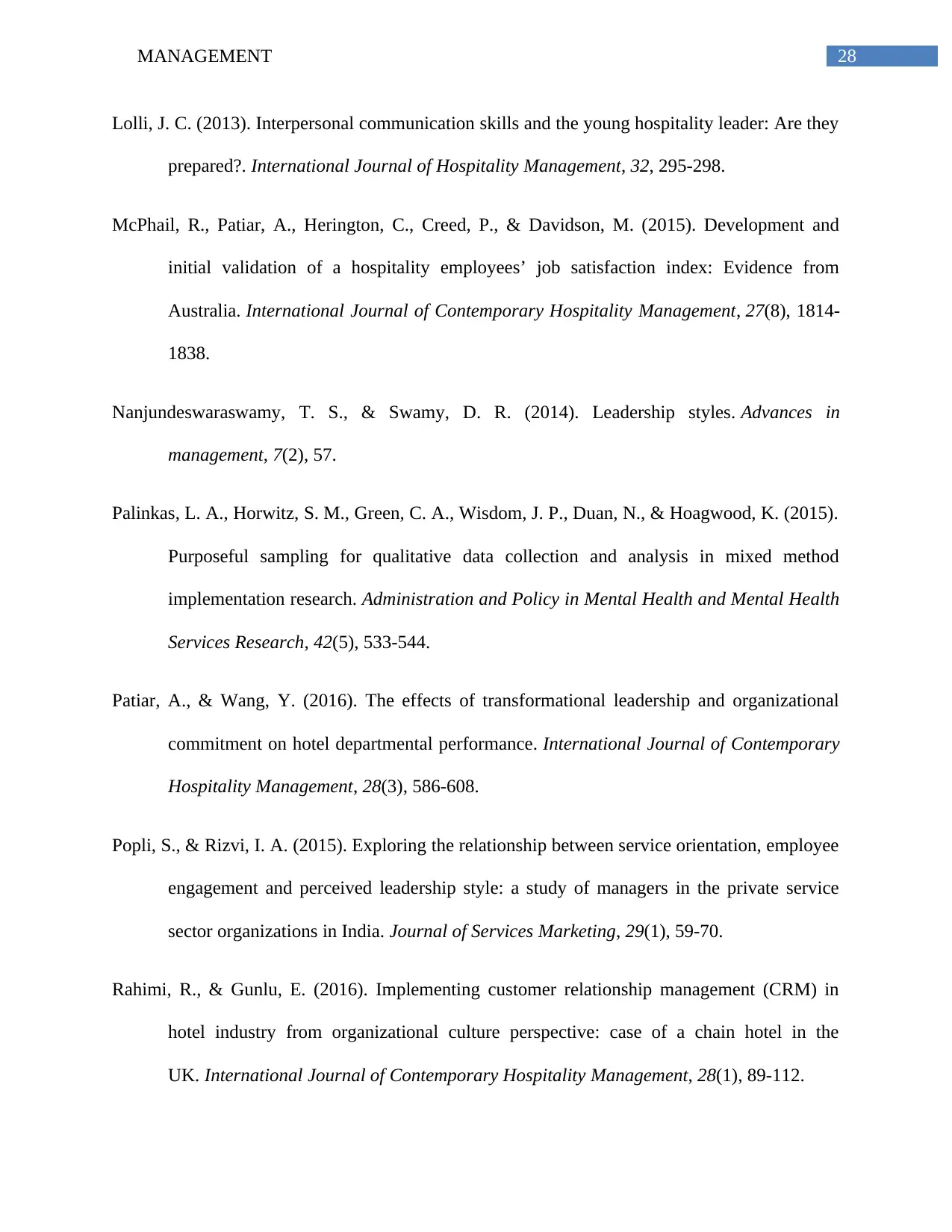
28MANAGEMENT
Lolli, J. C. (2013). Interpersonal communication skills and the young hospitality leader: Are they
prepared?. International Journal of Hospitality Management, 32, 295-298.
McPhail, R., Patiar, A., Herington, C., Creed, P., & Davidson, M. (2015). Development and
initial validation of a hospitality employees’ job satisfaction index: Evidence from
Australia. International Journal of Contemporary Hospitality Management, 27(8), 1814-
1838.
Nanjundeswaraswamy, T. S., & Swamy, D. R. (2014). Leadership styles. Advances in
management, 7(2), 57.
Palinkas, L. A., Horwitz, S. M., Green, C. A., Wisdom, J. P., Duan, N., & Hoagwood, K. (2015).
Purposeful sampling for qualitative data collection and analysis in mixed method
implementation research. Administration and Policy in Mental Health and Mental Health
Services Research, 42(5), 533-544.
Patiar, A., & Wang, Y. (2016). The effects of transformational leadership and organizational
commitment on hotel departmental performance. International Journal of Contemporary
Hospitality Management, 28(3), 586-608.
Popli, S., & Rizvi, I. A. (2015). Exploring the relationship between service orientation, employee
engagement and perceived leadership style: a study of managers in the private service
sector organizations in India. Journal of Services Marketing, 29(1), 59-70.
Rahimi, R., & Gunlu, E. (2016). Implementing customer relationship management (CRM) in
hotel industry from organizational culture perspective: case of a chain hotel in the
UK. International Journal of Contemporary Hospitality Management, 28(1), 89-112.
Lolli, J. C. (2013). Interpersonal communication skills and the young hospitality leader: Are they
prepared?. International Journal of Hospitality Management, 32, 295-298.
McPhail, R., Patiar, A., Herington, C., Creed, P., & Davidson, M. (2015). Development and
initial validation of a hospitality employees’ job satisfaction index: Evidence from
Australia. International Journal of Contemporary Hospitality Management, 27(8), 1814-
1838.
Nanjundeswaraswamy, T. S., & Swamy, D. R. (2014). Leadership styles. Advances in
management, 7(2), 57.
Palinkas, L. A., Horwitz, S. M., Green, C. A., Wisdom, J. P., Duan, N., & Hoagwood, K. (2015).
Purposeful sampling for qualitative data collection and analysis in mixed method
implementation research. Administration and Policy in Mental Health and Mental Health
Services Research, 42(5), 533-544.
Patiar, A., & Wang, Y. (2016). The effects of transformational leadership and organizational
commitment on hotel departmental performance. International Journal of Contemporary
Hospitality Management, 28(3), 586-608.
Popli, S., & Rizvi, I. A. (2015). Exploring the relationship between service orientation, employee
engagement and perceived leadership style: a study of managers in the private service
sector organizations in India. Journal of Services Marketing, 29(1), 59-70.
Rahimi, R., & Gunlu, E. (2016). Implementing customer relationship management (CRM) in
hotel industry from organizational culture perspective: case of a chain hotel in the
UK. International Journal of Contemporary Hospitality Management, 28(1), 89-112.
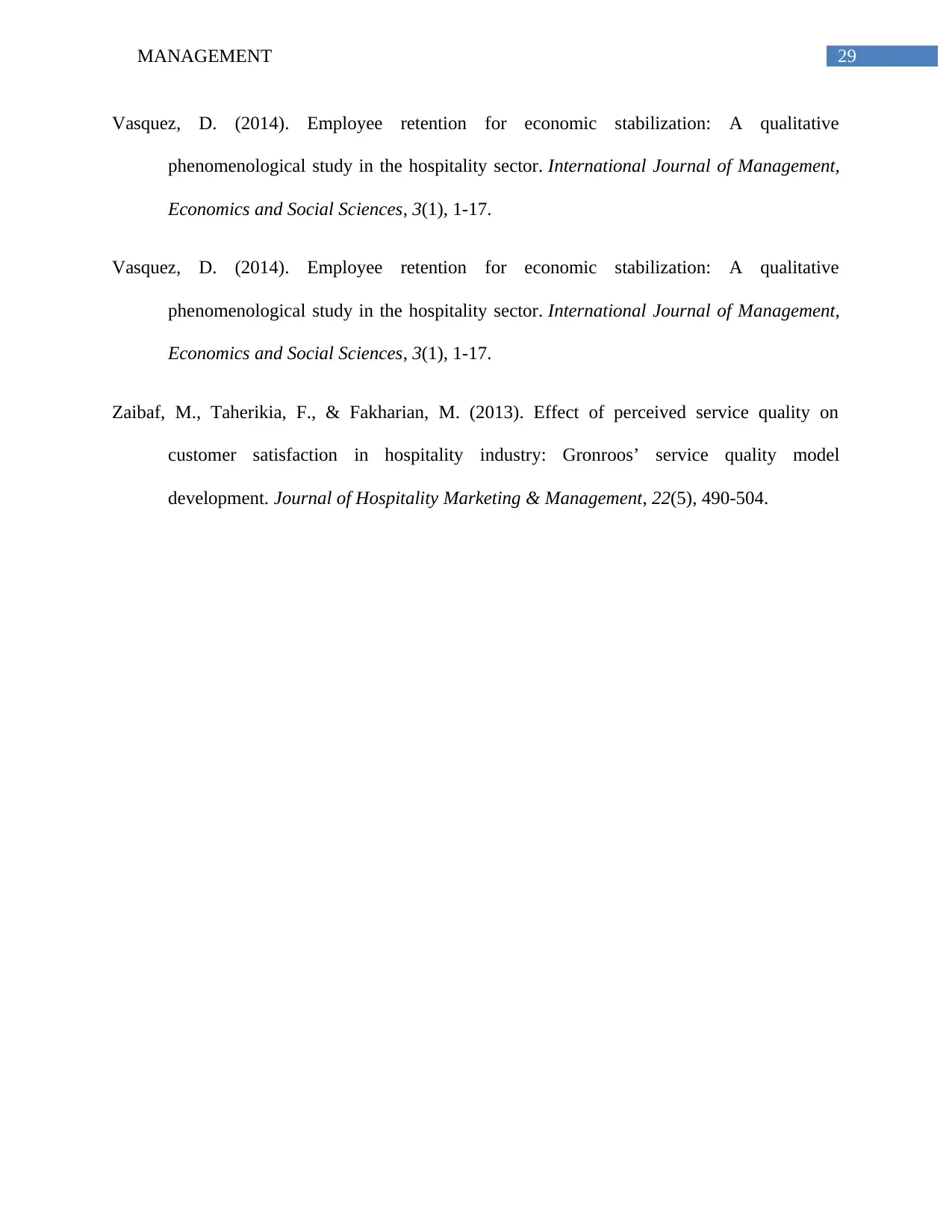
29MANAGEMENT
Vasquez, D. (2014). Employee retention for economic stabilization: A qualitative
phenomenological study in the hospitality sector. International Journal of Management,
Economics and Social Sciences, 3(1), 1-17.
Vasquez, D. (2014). Employee retention for economic stabilization: A qualitative
phenomenological study in the hospitality sector. International Journal of Management,
Economics and Social Sciences, 3(1), 1-17.
Zaibaf, M., Taherikia, F., & Fakharian, M. (2013). Effect of perceived service quality on
customer satisfaction in hospitality industry: Gronroos’ service quality model
development. Journal of Hospitality Marketing & Management, 22(5), 490-504.
Vasquez, D. (2014). Employee retention for economic stabilization: A qualitative
phenomenological study in the hospitality sector. International Journal of Management,
Economics and Social Sciences, 3(1), 1-17.
Vasquez, D. (2014). Employee retention for economic stabilization: A qualitative
phenomenological study in the hospitality sector. International Journal of Management,
Economics and Social Sciences, 3(1), 1-17.
Zaibaf, M., Taherikia, F., & Fakharian, M. (2013). Effect of perceived service quality on
customer satisfaction in hospitality industry: Gronroos’ service quality model
development. Journal of Hospitality Marketing & Management, 22(5), 490-504.
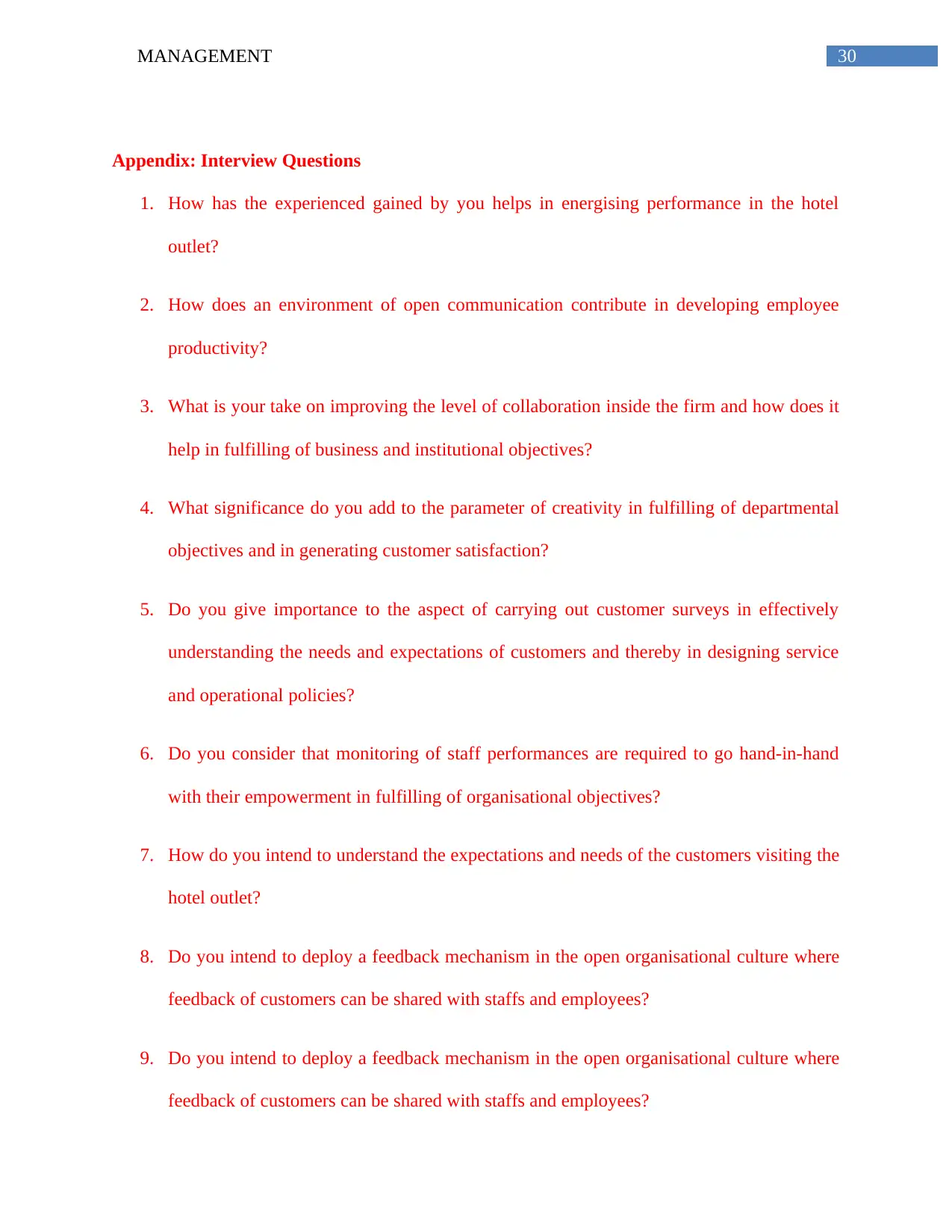
30MANAGEMENT
Appendix: Interview Questions
1. How has the experienced gained by you helps in energising performance in the hotel
outlet?
2. How does an environment of open communication contribute in developing employee
productivity?
3. What is your take on improving the level of collaboration inside the firm and how does it
help in fulfilling of business and institutional objectives?
4. What significance do you add to the parameter of creativity in fulfilling of departmental
objectives and in generating customer satisfaction?
5. Do you give importance to the aspect of carrying out customer surveys in effectively
understanding the needs and expectations of customers and thereby in designing service
and operational policies?
6. Do you consider that monitoring of staff performances are required to go hand-in-hand
with their empowerment in fulfilling of organisational objectives?
7. How do you intend to understand the expectations and needs of the customers visiting the
hotel outlet?
8. Do you intend to deploy a feedback mechanism in the open organisational culture where
feedback of customers can be shared with staffs and employees?
9. Do you intend to deploy a feedback mechanism in the open organisational culture where
feedback of customers can be shared with staffs and employees?
Appendix: Interview Questions
1. How has the experienced gained by you helps in energising performance in the hotel
outlet?
2. How does an environment of open communication contribute in developing employee
productivity?
3. What is your take on improving the level of collaboration inside the firm and how does it
help in fulfilling of business and institutional objectives?
4. What significance do you add to the parameter of creativity in fulfilling of departmental
objectives and in generating customer satisfaction?
5. Do you give importance to the aspect of carrying out customer surveys in effectively
understanding the needs and expectations of customers and thereby in designing service
and operational policies?
6. Do you consider that monitoring of staff performances are required to go hand-in-hand
with their empowerment in fulfilling of organisational objectives?
7. How do you intend to understand the expectations and needs of the customers visiting the
hotel outlet?
8. Do you intend to deploy a feedback mechanism in the open organisational culture where
feedback of customers can be shared with staffs and employees?
9. Do you intend to deploy a feedback mechanism in the open organisational culture where
feedback of customers can be shared with staffs and employees?
Paraphrase This Document
Need a fresh take? Get an instant paraphrase of this document with our AI Paraphraser
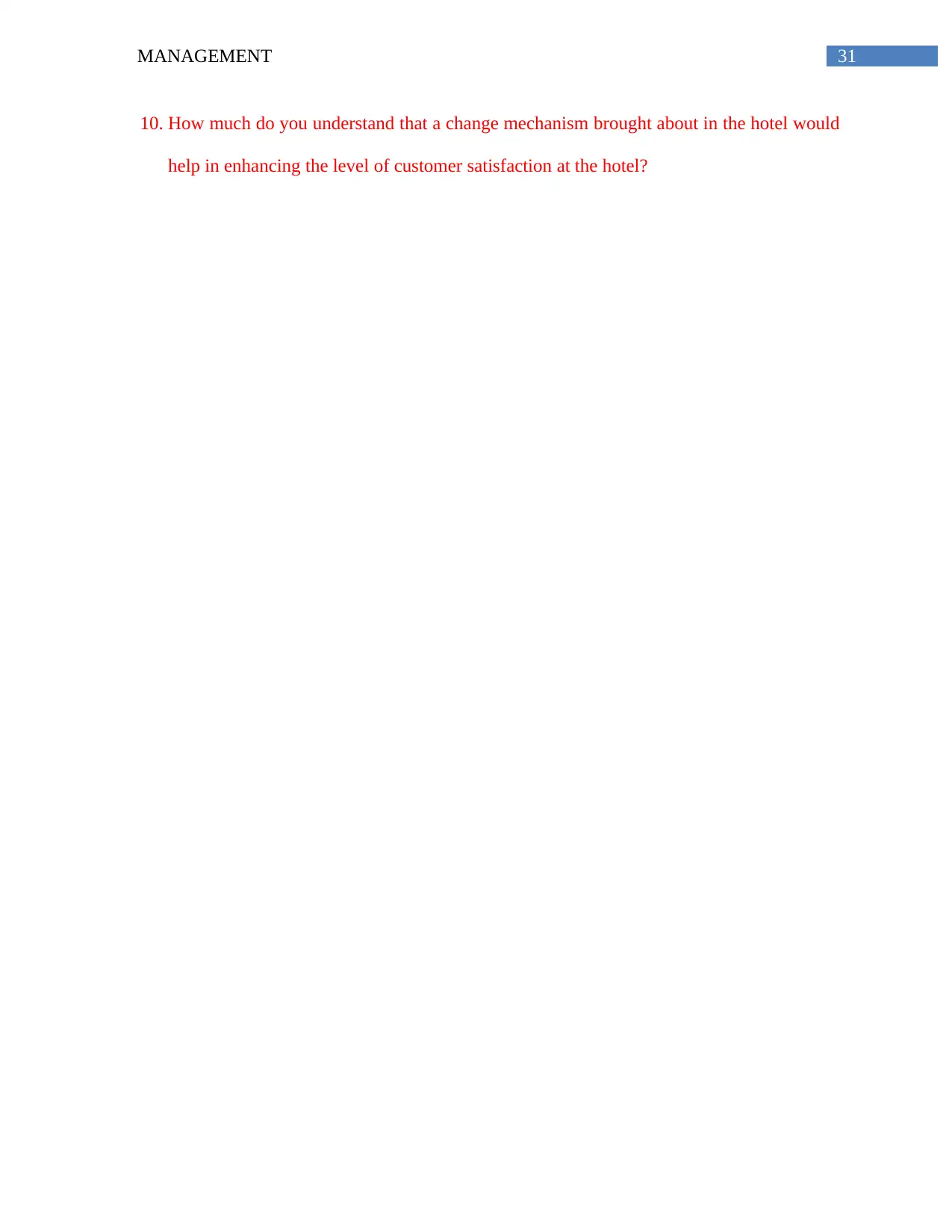
31MANAGEMENT
10. How much do you understand that a change mechanism brought about in the hotel would
help in enhancing the level of customer satisfaction at the hotel?
10. How much do you understand that a change mechanism brought about in the hotel would
help in enhancing the level of customer satisfaction at the hotel?
1 out of 32
Your All-in-One AI-Powered Toolkit for Academic Success.
+13062052269
info@desklib.com
Available 24*7 on WhatsApp / Email
![[object Object]](/_next/static/media/star-bottom.7253800d.svg)
Unlock your academic potential
© 2024 | Zucol Services PVT LTD | All rights reserved.





